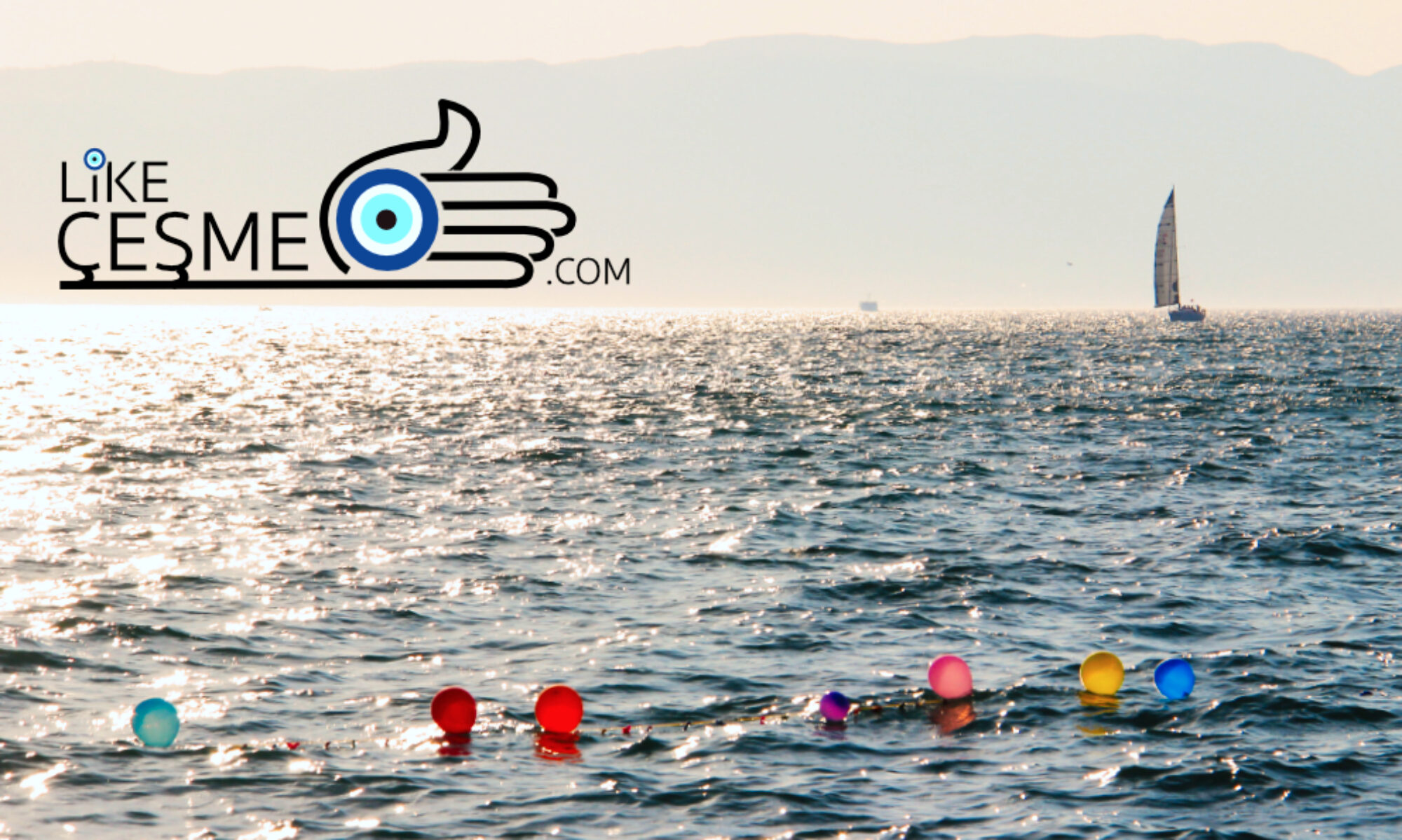The fountains of Çeşme form a critical part of its heritage since the direct modern translation of ‘Çeşme’ from Turkish is ‘Fountain’, a description of the town almost certainly derived from the plentiful and varied water supplies in and around Çeşme, including thermal springs and potable water supplies provided for both local inhabitants and transient mariners restocking their provisions through the ages. The varied Ottoman fountains of Çeşme are a link to the town’s past and a reminder of its social history.
Fountains of Çeşme – Table of Contents
Necessity & Usage of the Ottoman Fountains
Globally, until the early 20th century, plumbing supplying running water to homes was rare. During the Ottoman era, houses were provided mainly by an ornately dressed Saka (water carrier) who collected water from public fountains of Çeşme in leather sacks and poured it into customers’ ceramic jars. Most homes contained a cistern that collected well or rainwater. However, this water was only suitable for daily use. The tanks would also be used to hang food to keep it cool and stop it from spoiling.
Ottoman Fountain Structure
Where the water supply to a fountain is not wholly consistent, the water collecting chamber (such as with the Murabutzade and Castle Street fountains of Çeşme) is a principal element collecting water as a safeguard against drought and water shortage. Terracotta pipes linked to the central supply system provide water intake to the fountain chambers.
The chamber keeps water cooled and provides distillation against impurities, collected up to a level of 20-25 cm at the base, above which the water is released to flow through the spout. Typically, impermeable plaster covers half the chamber; above this, the stone is left uncovered to allow for evaporation, with an overflow hole immediately above the water collection level to expel any excess water. The upper level has a cleaning and maintenance opening typically covered with a shutter blind. Brick or stone domes form the roof of most fountains.
The Fountains of Çeşme
Çeşme, translating to “fountain” in Turkish, boasts a rich heritage of Ottoman-era fountains that highlight its historical significance and the importance of water to the community. These fountains, constructed between the 16th and 19th centuries, provided essential water sources and showcased intricate architectural designs. Notable fountains of Çeşme examples include the Castle Fountain (1508), one of the earliest known, and the Hamaloğlu or Hafize Rabia Hatun Fountain (1851), distinguished by its rectangular plan and three façades.
The fountains of Çeşme served practical and social functions, acting as a communal gathering spot and reflecting the town’s prosperity. The Memiş Ağa Fountain (1798) and the Saliha Fountain (1800) are other significant examples, each with unique architectural features and historical contexts. Today, these fountains are enduring symbols of Çeşme’s cultural and architectural legacy, offering insights into the town’s Ottoman past and longstanding relationship with water.
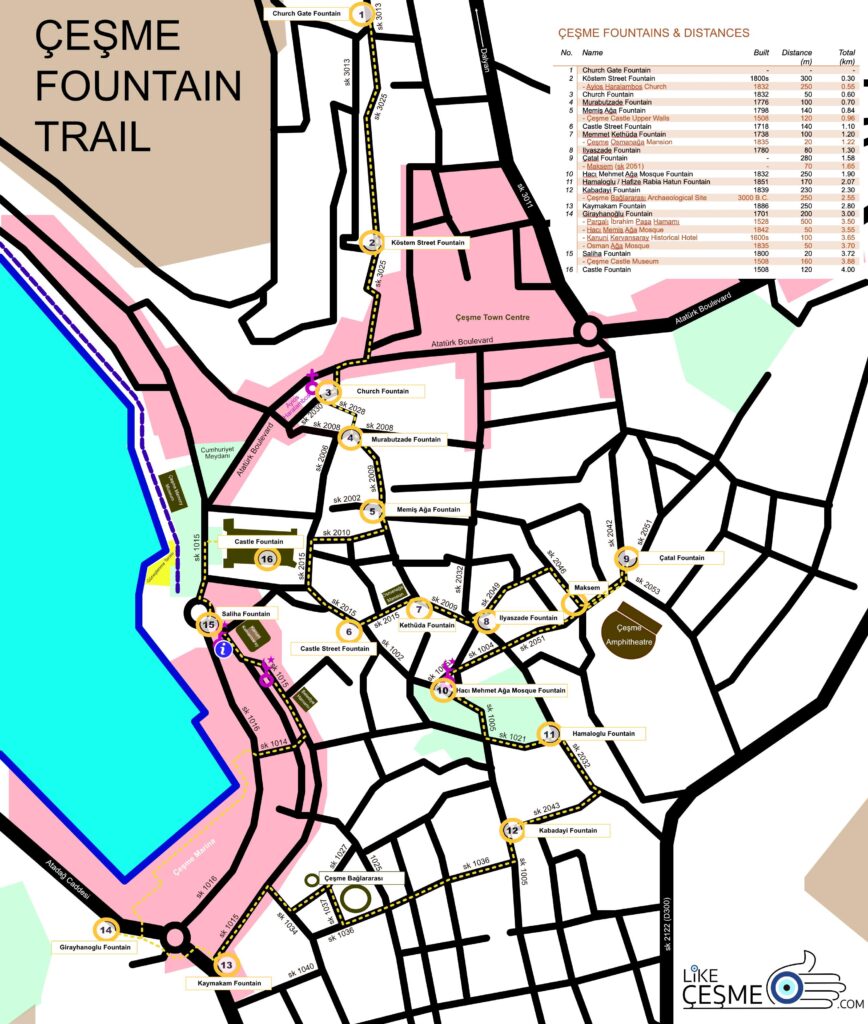
Below is a selection of 15 fountains of Çeşme that can be found today in the centre of town; they are listed in order of viewing following a route through Çeşme north to south. Each of the fountains of Çeşme are have descriptions on their characteristics and respective locations:
Church Gate Fountain (unknown date)
The Church Gate Fountain is located on Sk. 3013 (between Sk. 3023 and Sk. 3021) adjacent to an old church gate (unknown demolished church). It is set on a wall with dimensions 1.94m x 1.57m x 0.18m/0.74m. Çeşme Municipality owns the fountain, but like the Köste Street Wall Fountain, which has been destroyed, it has no listing/preservation order. The old church gate has had a listed preservation order since July 1992 but is also in precarious condition and supported by scaffolding.
The fountain was built as a simple wall with pediment and covered with decorative tiles. Photographic records illustrate that it was built with slate stone and ended with a pediment, and was ornamented in the centre, with spherical knobs on the jug shelves at either side.
While it was slate stone in the past, after 1988, it was concreted over and covered with decorative tiles with no ornamentation. All original properties are missing, and it would require complete reconstruction according to old photographs. The fountain is surrounded by building materials, parked vehicles and marked with graffiti. The modern tiles are also in severe decay, broken, and covered in graffiti.
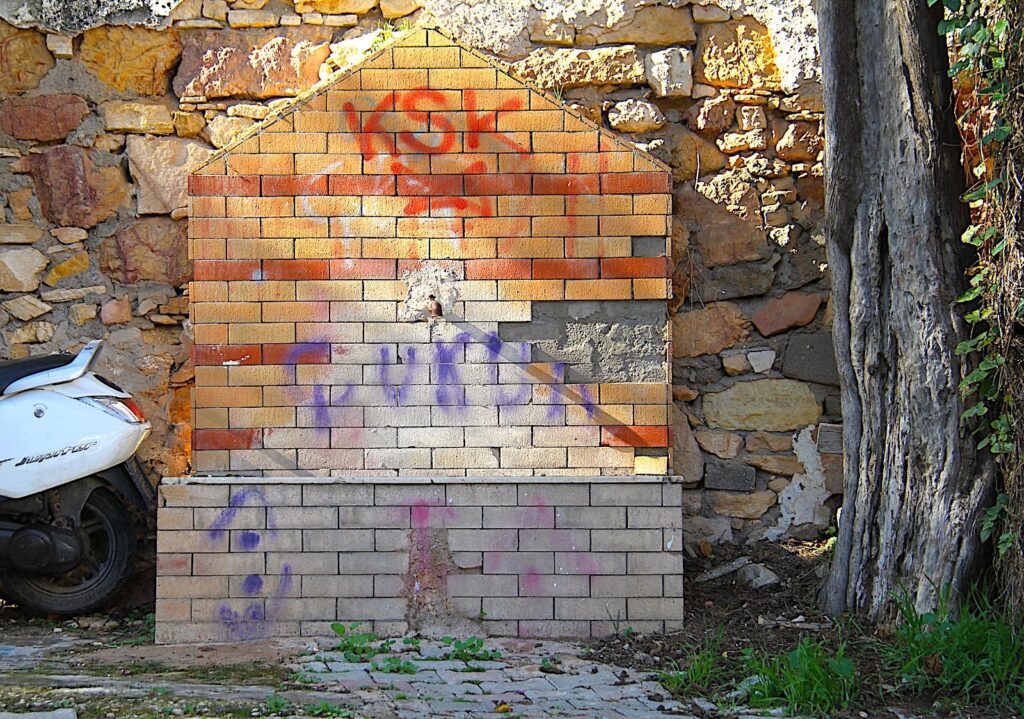
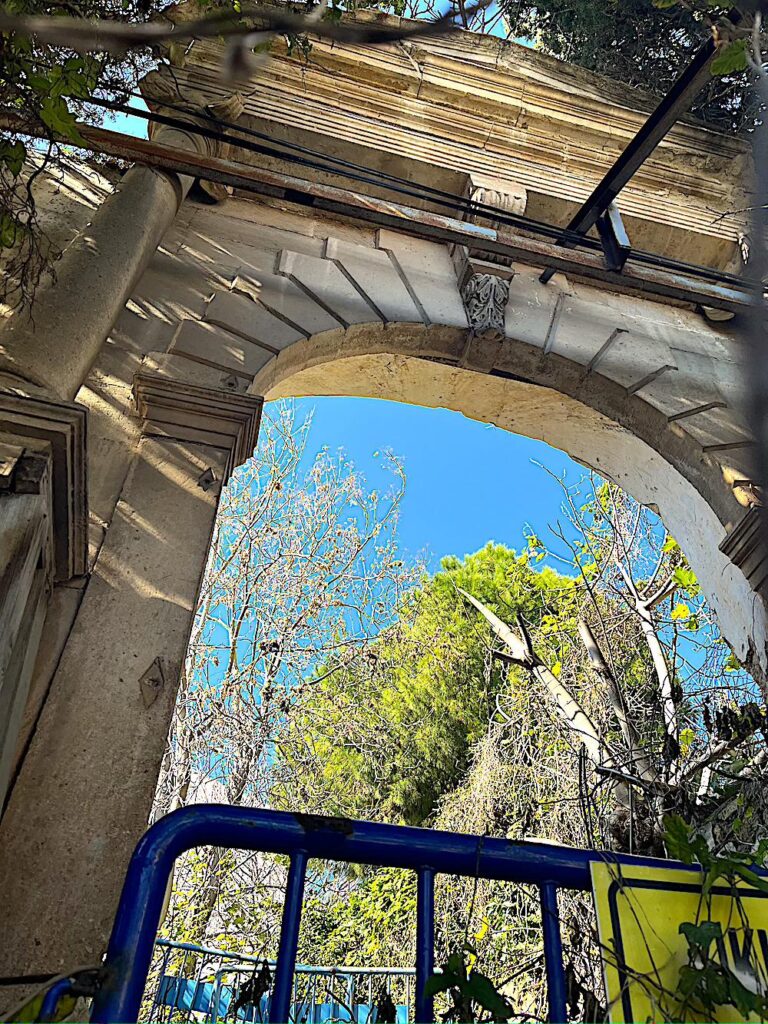
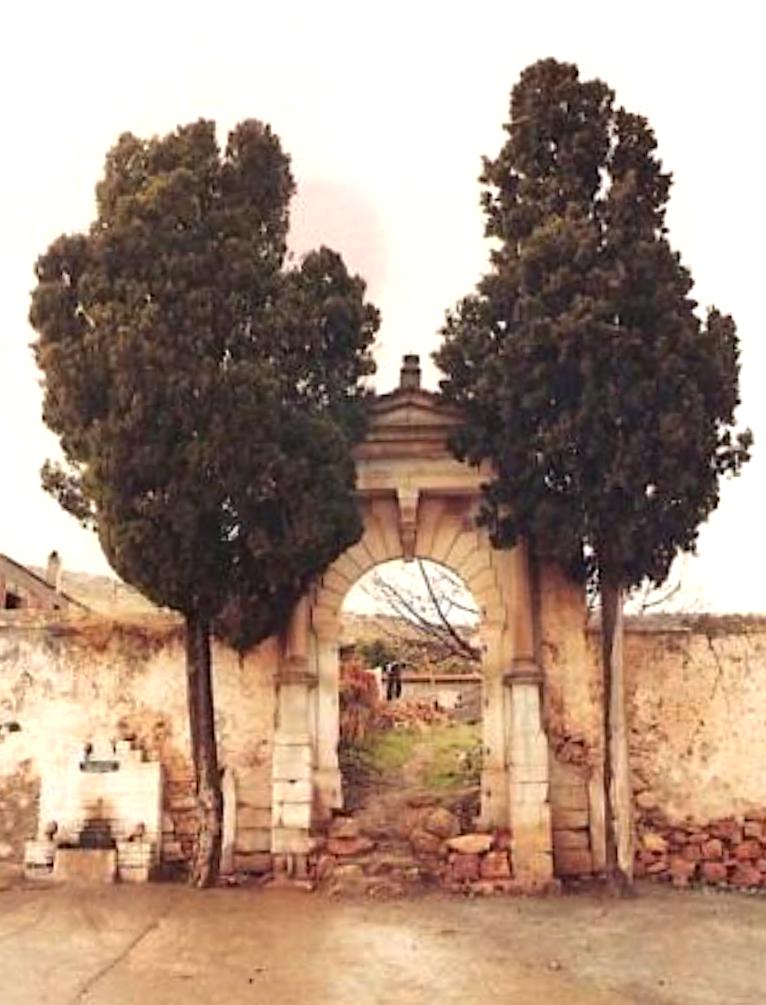
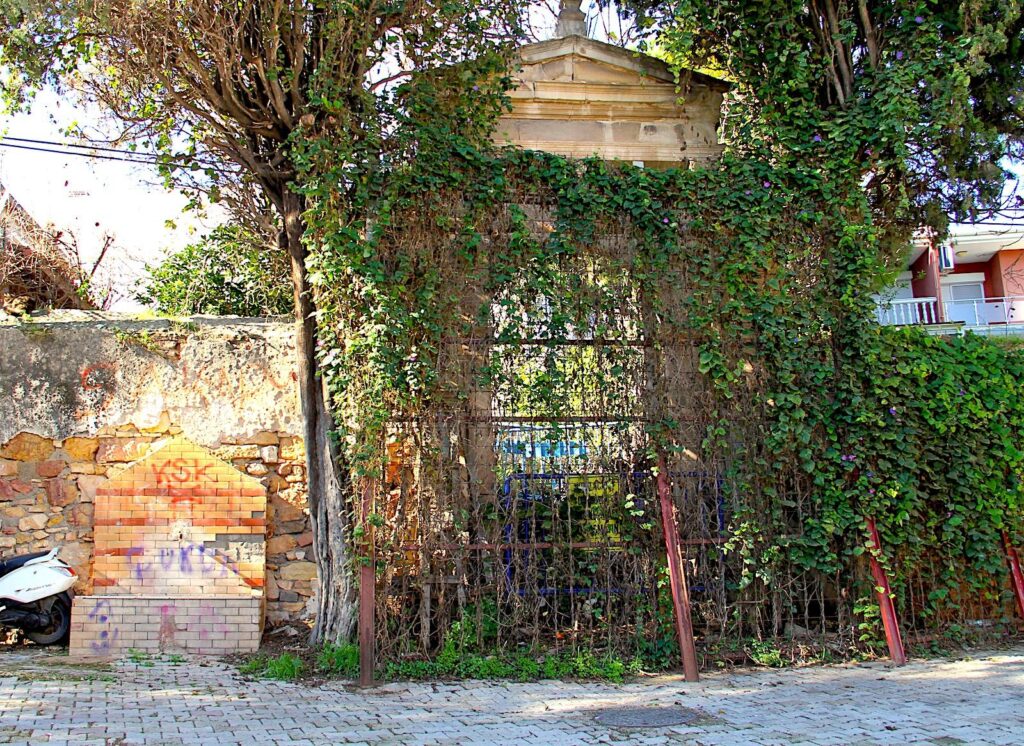
The historical picture of the Church Gate & Fountain above is extracted from Investigation of the Ottoman Period Fountains in İzmır/Çeşme for their Preservation by Ahmet Karaçöl, March 2011, figure 4.106 Page 160, attributed to “İzmir Number 1 Regional Board for the Conservation of Cultural and Natural Assets.”
Köste Street Fountain (Unknown circa late C19th)
The Köste Street Fountain is located at the junction of Sk. 3025 (previously Köste Street)/3033. It is currently freestanding but previously was attached to the demolished property boundary wall. It has dimensions of 3.19m x 2.53m x 2.42m. The fountain was listed for preservation by İzmir Regional Board for the Conservation of Cultural and Natural Assets in July 1992 (decision number 3889); the owner is Çeşme Municipality.
The attachment of a garden wall to the north façade damaged it previously, but it has since been removed. It is restored, cleared from a plaster covering, and in good condition today. It is constructed with cut stone and rubble masonry and has a pitched roof. While the inscription panel is missing the original lead pipes used in the area, it indicates the fountain was built in the 19th century and was previously connected to the Hacı Memiş Ağa water system with lead pipes.
The municipality plaque inscription reads: “As there isn’t a subscription, the date of construction and the person who built it is unknown.”
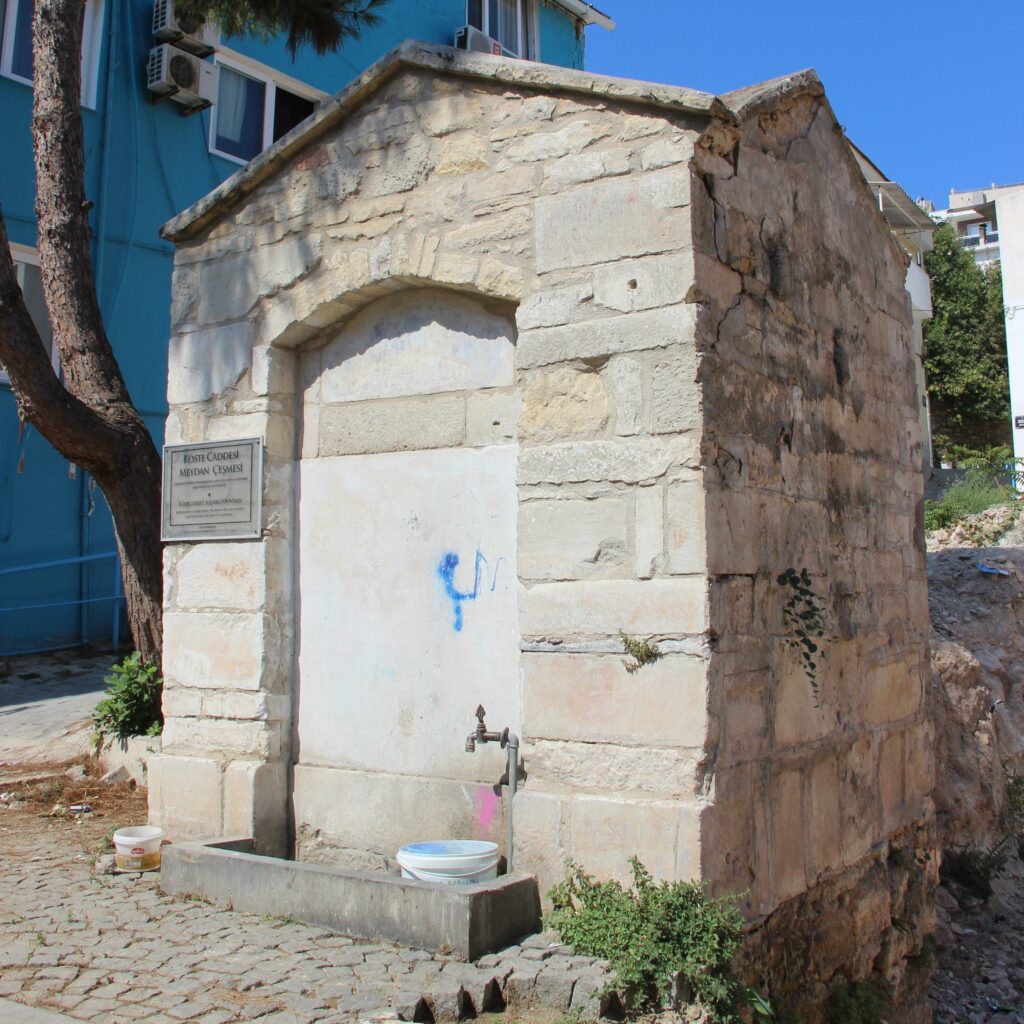
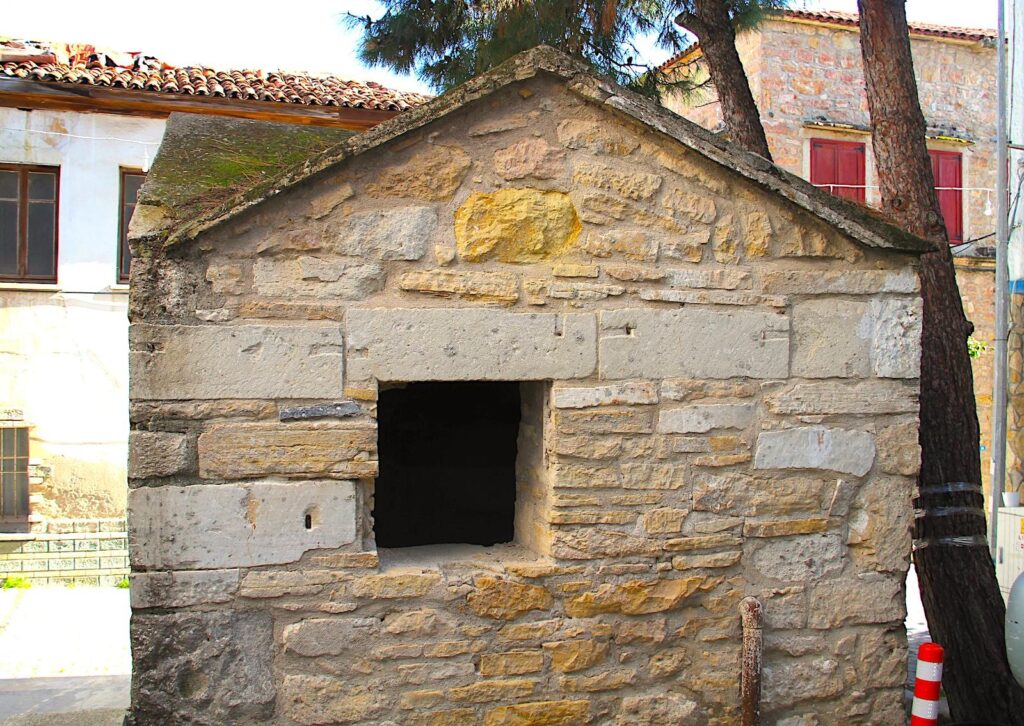
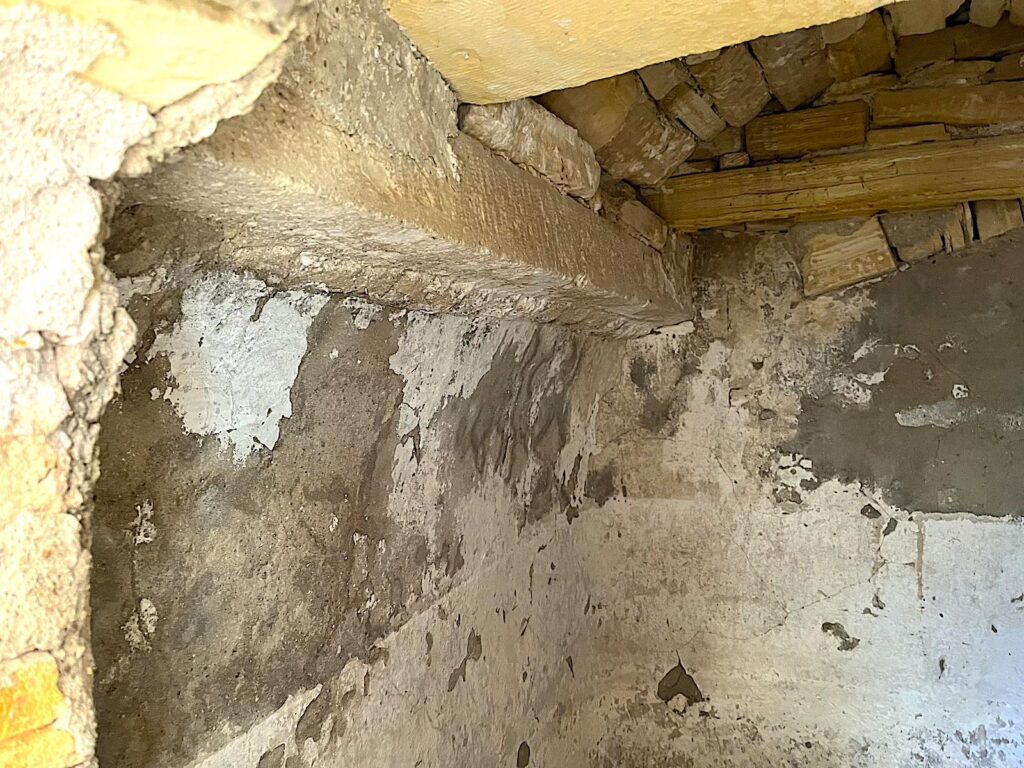
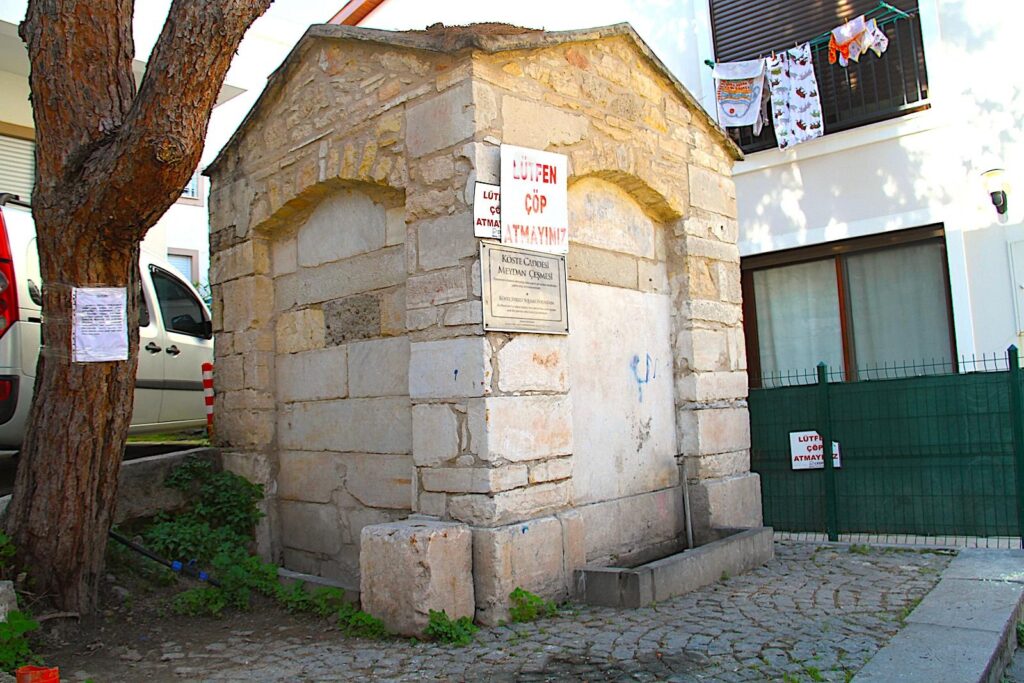
Church Fountain (1832)
Church Fountain is located on Sk. 2030 behind Ayios Haralambos Church, opposite Sk. 2028 walkway. It is set directly on the church wall and has dimensions of 1.99m x 1.45m x 0.58m. It was relocated from Atatürk Boulevard (formerly İnkilap Caddesi) on the north side of the church after 1988.
The fountain was constructed together with the church built around the 18th century. The fountain and the church are owned by Çeşme Municipality and were listed for conservation updated in July 1992 by Number 1 İzmir Regional Board for the Conservation of Cultural and Natural Assets (decision no. 3889).
Galvanised pipes connected the water supply system to the Hacı Memiş Ağa water network. The fountain would have had a water-collecting chamber with a dome in the past. The façade composition is a niche framed with a segmental profiled arch flattened at the extrados (exterior surface of the arch) resting on the walls at either side. The basin is placed in the niche on the stone blocks. It is currently used for sanitary and street cleaning purposes. There are few details about the original features of the fountain.
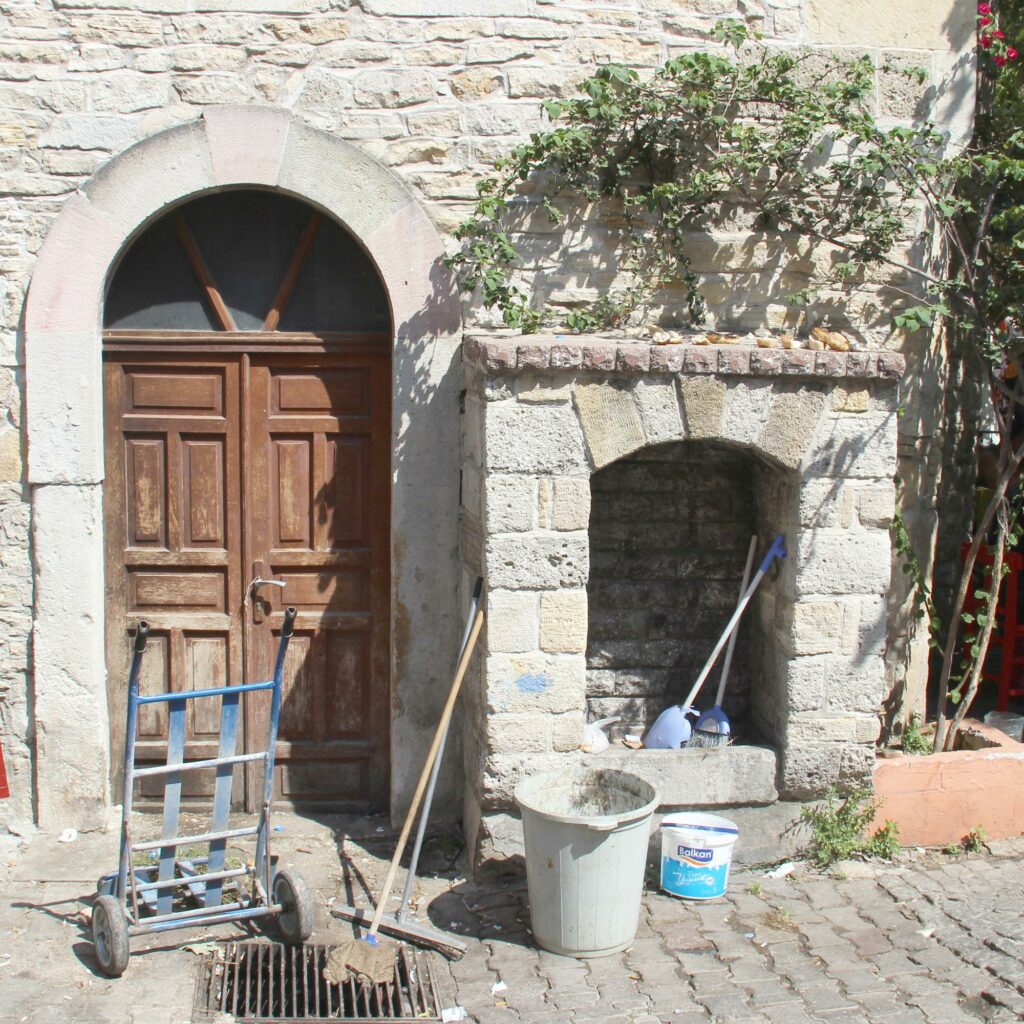
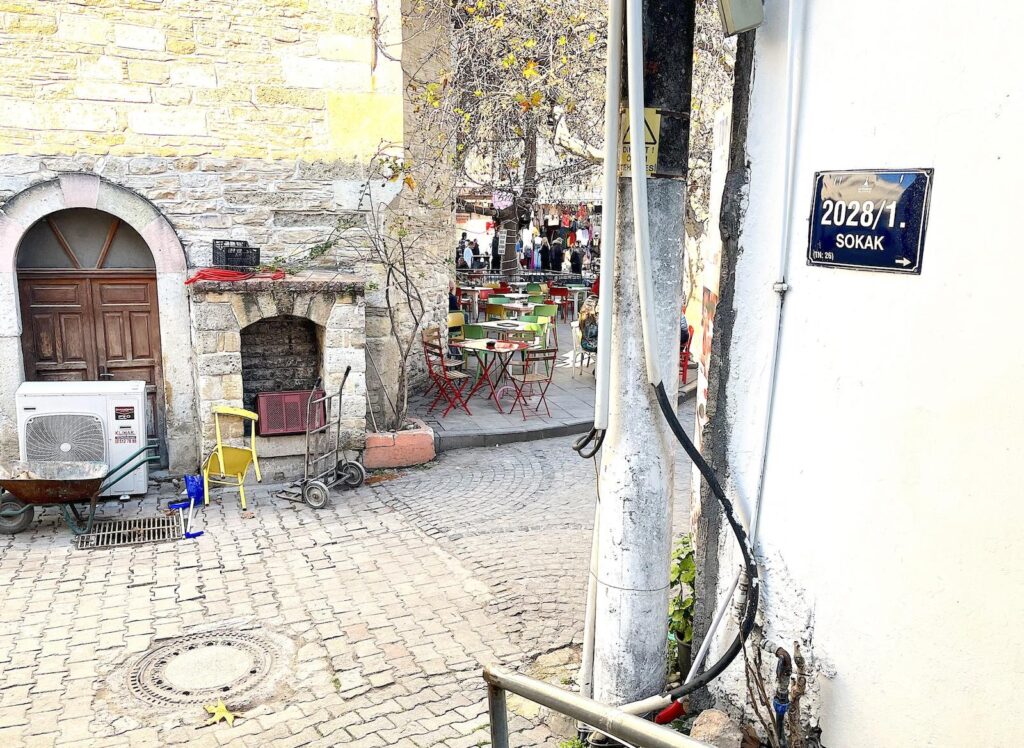
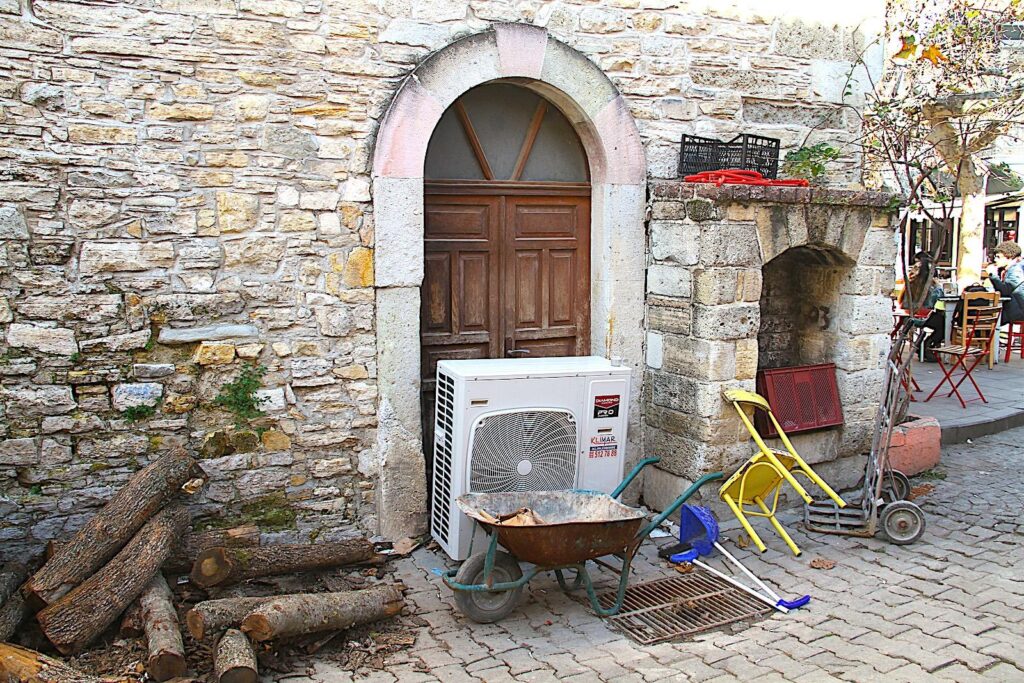
Murabutzade Fountain (1776)
The Murabutzade Fountain is located on Sk. 2006 at the corner of Sk. 2008/9 (formerly Keskin Street and Tepe Street). It is adjacent to two walls of a private residential building, and the roof forms a terrace. It was built by Ayşe Hatun in 1776 for her deceased husband, Murabutzade Hacı Hüseyin Kaptan.
The fountain, with a title deed of 11 square metres, is owned by Çeşme Municipality and was listed in July 1992 by the Number 1 İzmir Regional Board for the Conservation of Cultural and Natural Assets (decision no. 3889). The fountain’s dimensions are 2.86m x 3.10m x 3.50m. It was substantially renovated before January 2015, including extensive plastering and overpainting removal.
The water supply system was initially connected to the Hacı Memiş Ağa water with terracotta pipes; it currently has galvanised pipes. It has a barrel vault, and its façade composes a niche framed with a pointed arch resting on plain impost stones and pilasters. A brick parapet wall surrounding the terrace of the house adjacent to the left was placed on the fountain. The left side is plain. It has cut stone in the front façade, rubble stone in the left and likely in other façades with no ornamentation. Conservation issues include possible improper use of the terrace above with potential excessive use of cement and spalling on the stone surface.
The municipality plaque was removed sometime between September 2015 and November 2018. Ahmet Karaçöl’s attribution in the study states, “Built by Ayşe Hatun for her deceased husband Murabutzade Hacı Hüseyin Kaptan in 1776” (Kayın 1988, Geyik 2007).
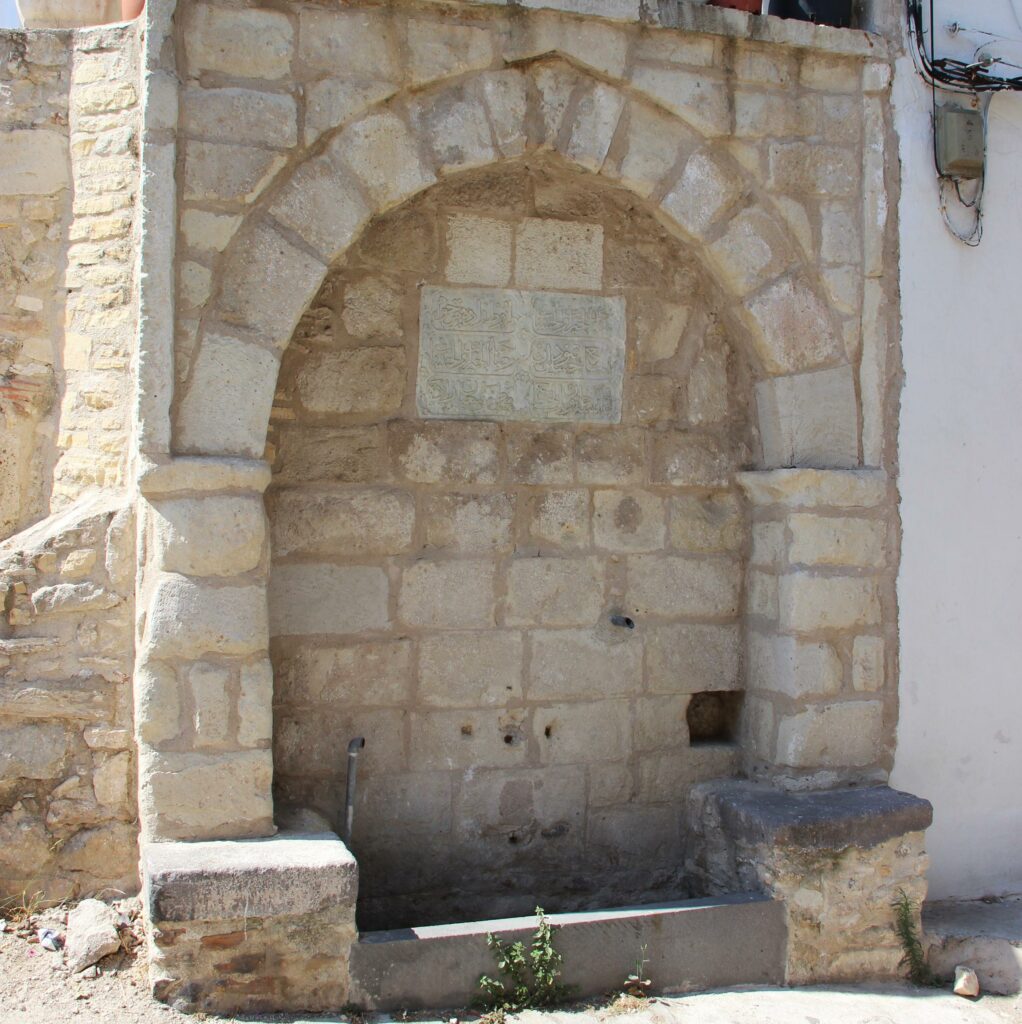
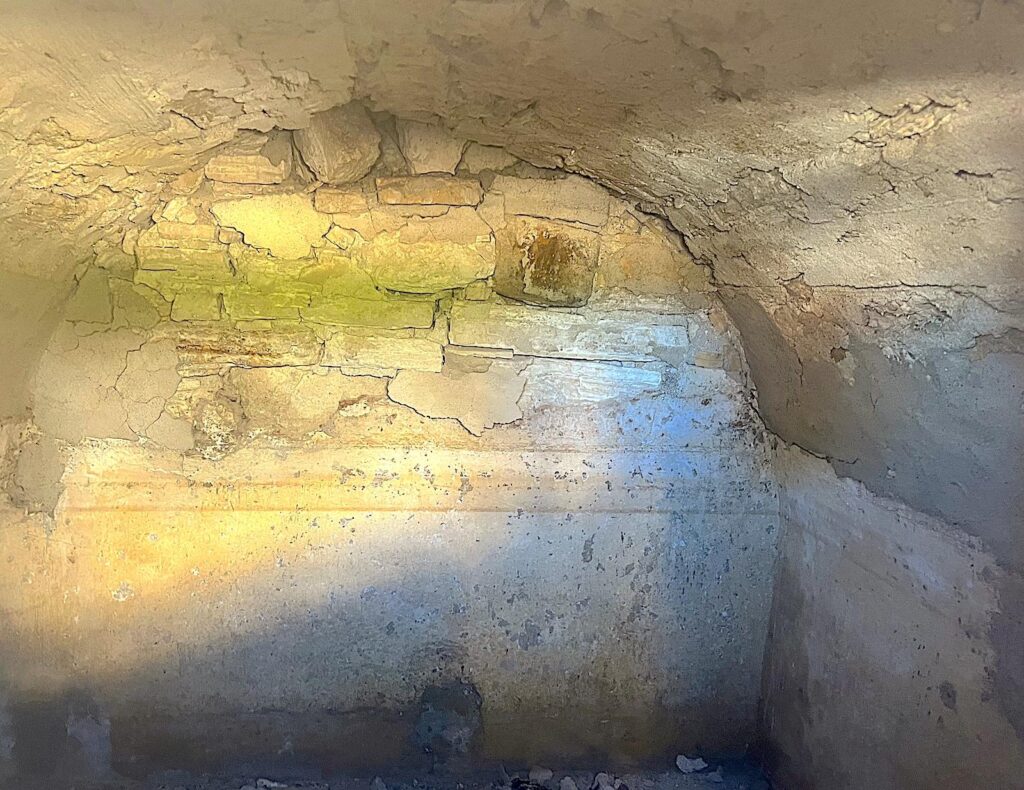
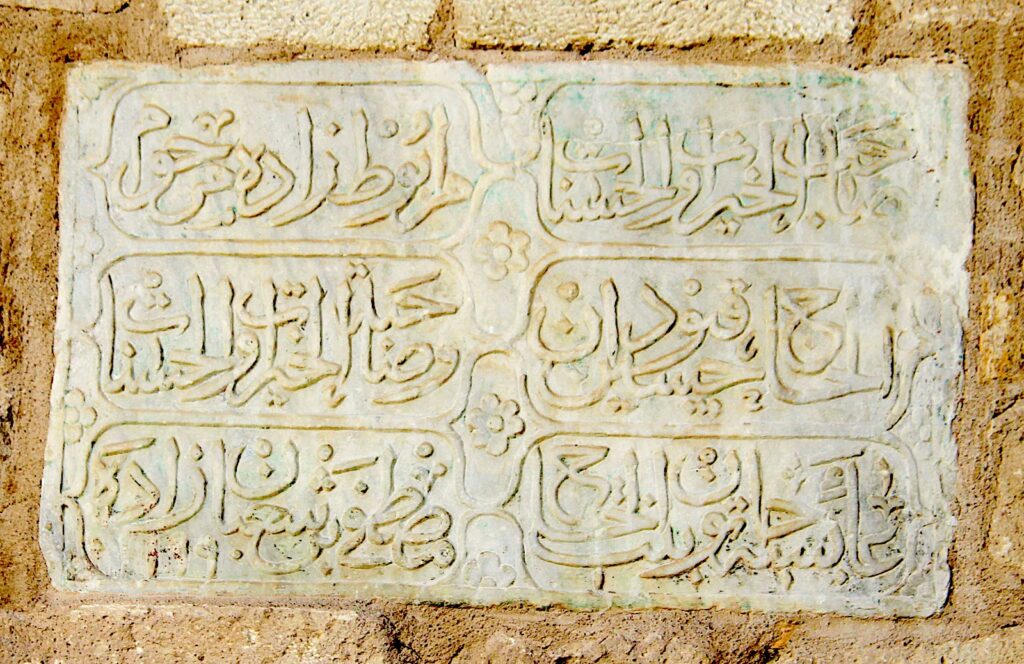
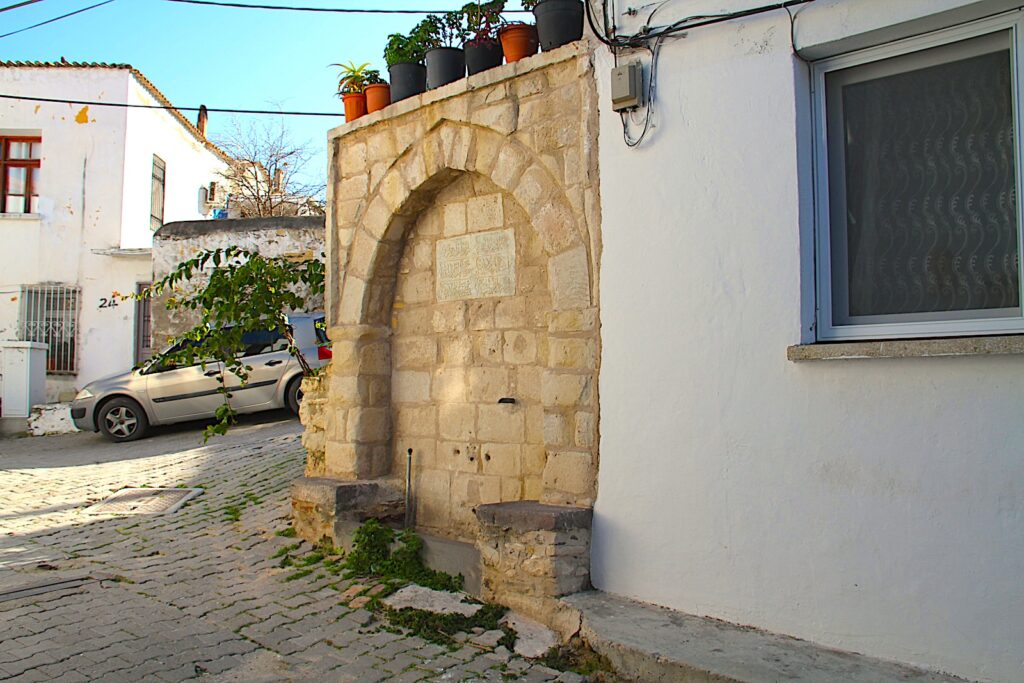
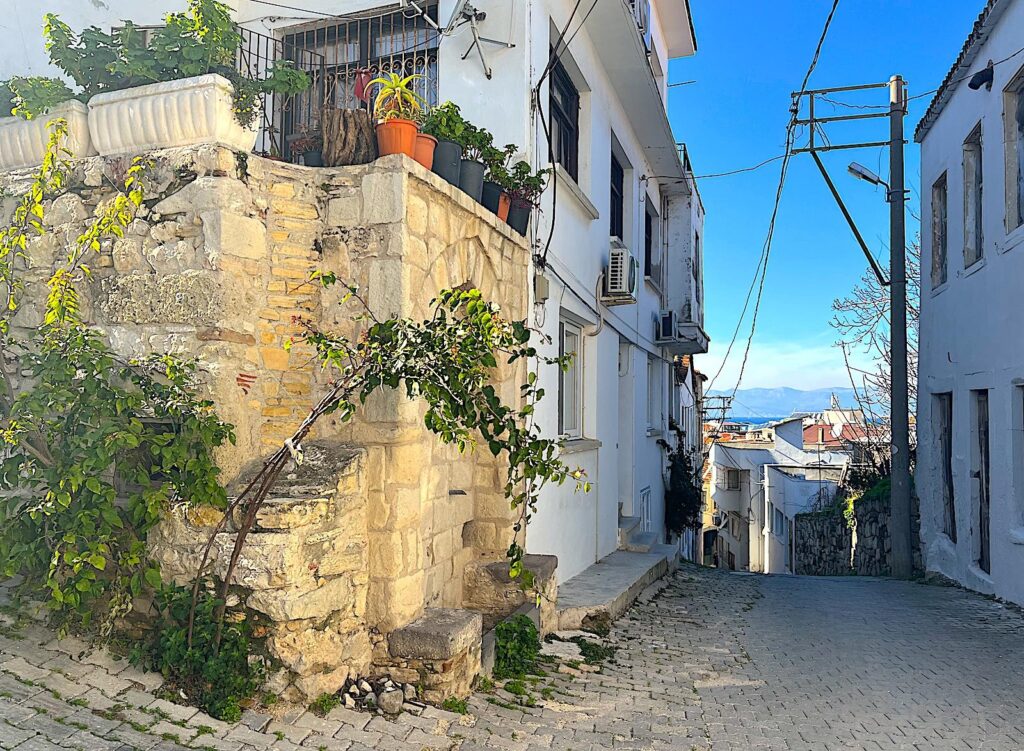
Memiş Ağa Fountain (1798)
The fountain is located on Sk. 2009 (formerly Maraş Street), at the corner of Sk. 2002 and forms part of a private residential building structure & walls. According to the inscription panel, the fountain was most likely erected together with the adjacent house, built by Memiş Ağa in 1798. The property and fountain are under private ownership and were listed for conservation, last updated in July 1992 (No. 3889) with the İzmir Regional Board for the Conservation of Cultural and Natural Assets.
The water supply system was initially connected to the Hacı Memiş Ağa water system with terracotta pipes. The fountain and basin are almost square and measure 2.54 metres in width and 2.64 metres in height. The façade is a niche framed with two pointed concentric arches resting on impost stones and pilasters. A profiled moulding was placed on top. Vertical mouldings are set on either side of the niche. An unfilled maintenance window was placed at the right-side façade at a height of 3 metres.
A power supply pylon interferes with the fountain’s appearance, and it is wholly encased in whitewash cement. The red plate inscription in Turkish reads, “Drinking water is not to be used for any other purpose.”
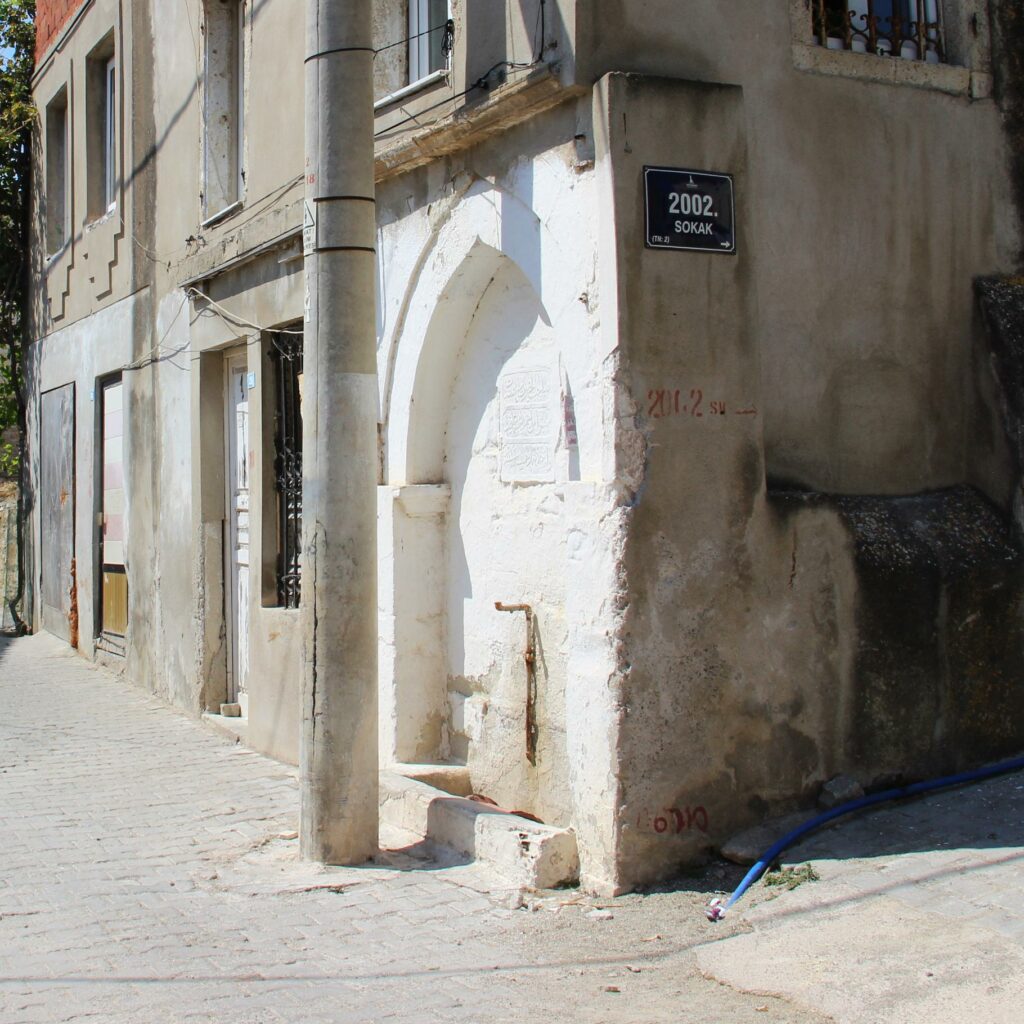
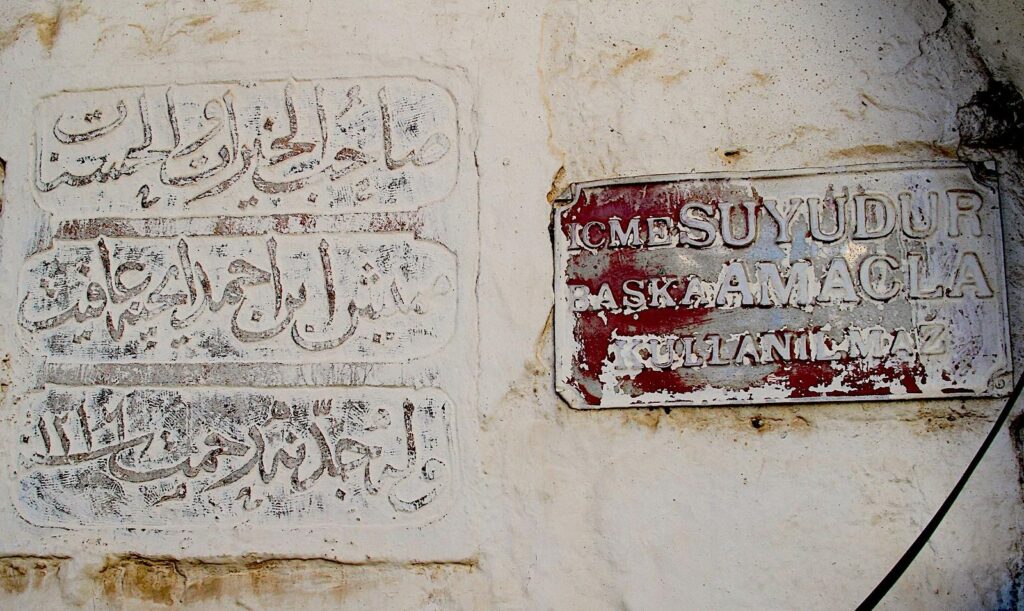
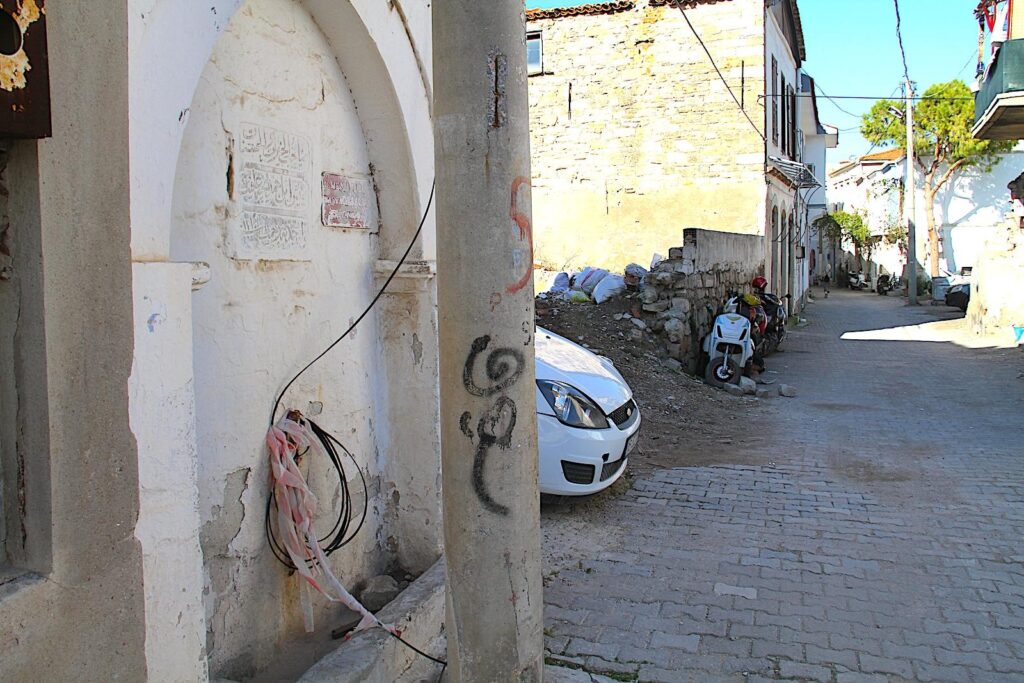
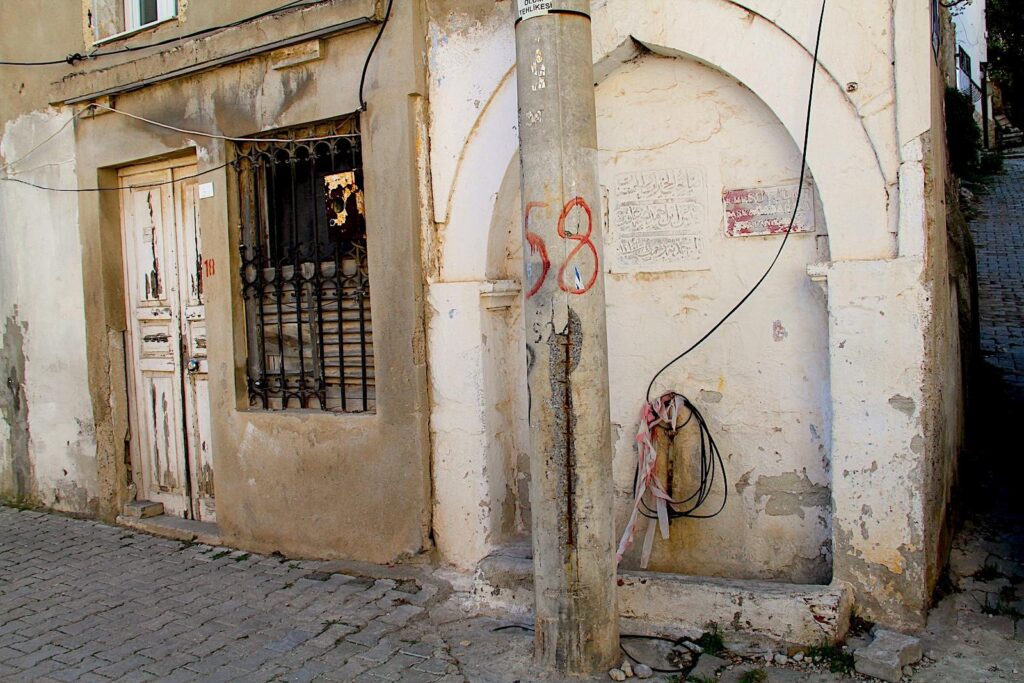
Castle Street Fountain (1718)
The Castle Street Fountain is located at the junction of Sk. 2015 and Sk. 1002. The Fountain was restored in 2012 from a plastered and painted state by Çeşme Municipality and Umart Mimerlik. The original inscription panel for the fountain was previously lost, and the existing inscription panel brought from another building gives information about the execution of İbrahim Pala by the order of Kanuni that occurred in 1718, a slightly earlier time. The fountain has architectural similarities to the Kethüda fountain, built in 1738.
The owner is the Çeşme Municipality, and the fountain with a seven square metre deed area has been listed for conservation status. It was updated in July 1992 (No. 3889) with the İzmir Regional Board for the Conservation of Cultural and Natural Assets.
The fountain water supply system was initially connected to the Hacı Memiş Ağa water with terracotta pipes through its water collecting chamber. It is almost square, 3.38 x 2.95 metres, together with basins. The façade of the residential building to the left (south) was renovated between 2021-2024, and the property was previously attached to the fountain to the rear sk. 1002, 20/1 was demolished circa 2020 and has since been built with a setback to the fountain, allowing access to the rear.
The fountain has a barrel vault, with a façade comprising a niche framed with a semicircular arch resting on the fountain on the left but protruding on the right. The inscription panel brought from another building and placed below the arch has invalided the bleeding hole of the chamber. The jug shelf on the right is missing, and the basin remains below the ground. The left façade finishes with a pediment and the same vault profile. The fountain is constructed with rubble stone in the mass, and andesite cut stone jug shelf and basin, as well as marble in all ornamented elements. The medallion above the frame of writing is an inscription panel, with medallion-like circular motives lined up with spout stone, likely a part of a sarcophagus cover.
In 2019, a Çeşme Municipality plaque was mounted on the fountain; between then and 2025, the plaque was removed. The inscription stated: “There’s a relatively big subscription in the middle of the humpback niche. The outer line of the subscription is not smooth, and the subscription text is written in thuluth as three lines. Above the text is a circular figure. As the subscription has been painted and damaged in this way, only these words can be read: ‘The prayer Fatiha for the spirit of ……who did works of charity and acquired merit by God.’ Year 1115”
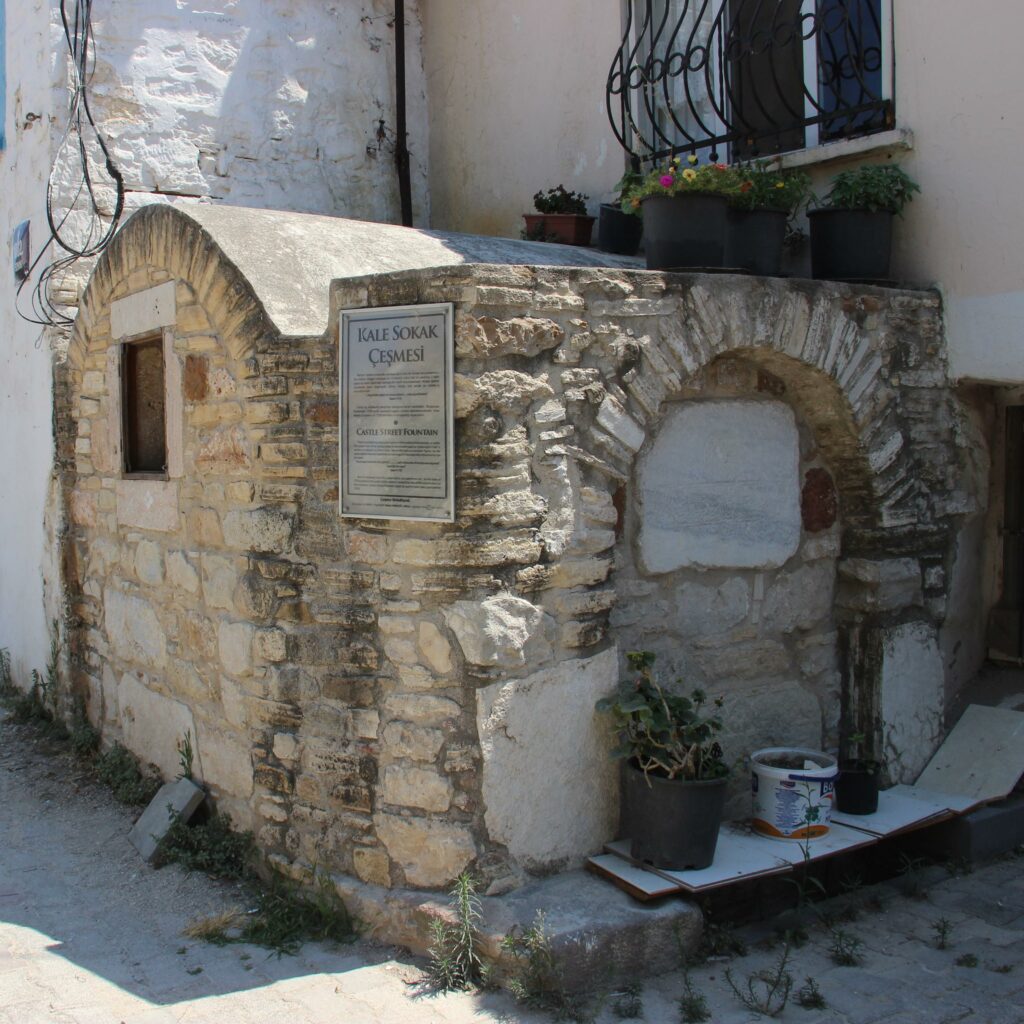
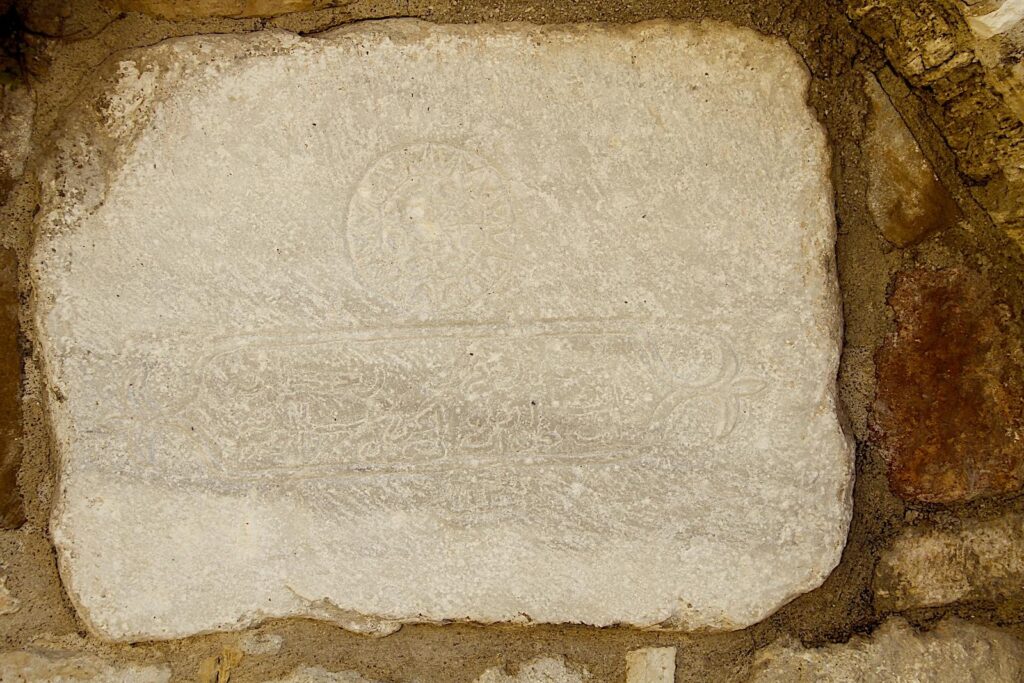
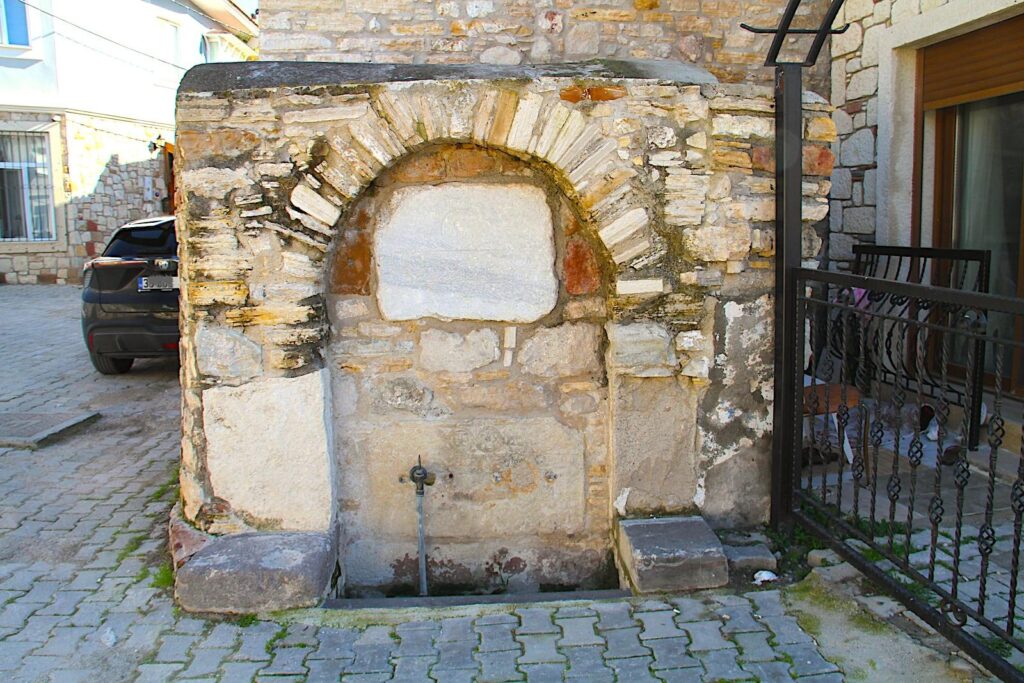
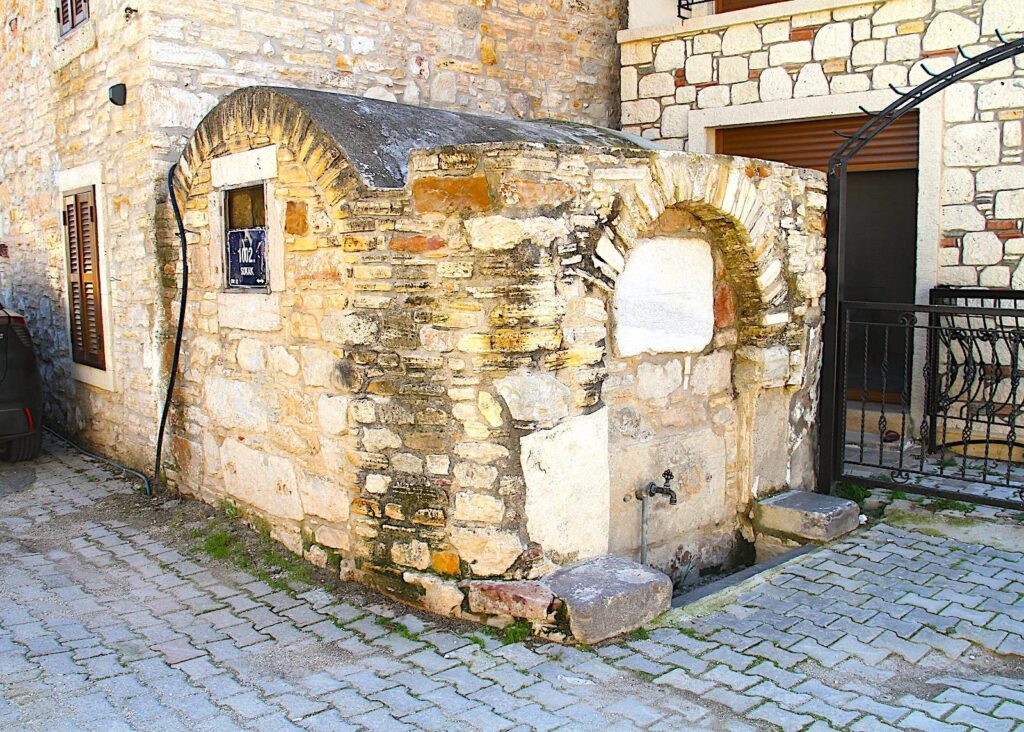
Memmet Kethüda Fountain (1738)
The Kethüda Fountain is located at the intersection of Sk. 2009 / 2015. Owned by the Çeşme Municipality, according to the inscription panel, it was built by Mehmet Kethüda in 1738. It was listed in July 1992 by the İzmir Regional Board for the Conservation of Cultural and Natural Assets. According to old photographs, the water supply system was initially connected to Hacı Memiş Ağa water system. It was dismantled in the 1980s and reconstructed in its original place but facing a different direction. The water-collecting chamber remained and was connected to the network with galvanised pipes.
The fountain is rectangular, measuring 2.88 metres in height and 90 cm in width. It would likely have had a vault in the past, but none of it has survived. The façade composition has a niche framed with two-centred pointed arches with a keystone pointed at intrados and extrados resting on impost stones and side walls, respectively. During the reconstruction in the 80s, the inscription panel and spout stone were mounted upside down. Jug shelves are placed on either side of the basin. The construction material is lime cut stone in the niche and arch, andesite spout stone, and rubble stone in the rear, right and left façades.
A plaque on the fountain notes that it was restored in 2012 by the Çeşme Municipality under the guidance of Project Author Ahmet Karacöl and Umart Architects. The plaque notes the 70 x 50 cm marble inscription is written in thuluth and states:
“That moon faced thought of building a new fountain. Kethüda Muhammed built that fountain for the sake of God. The water of the fountain comes from the cold and tasty water of the spring in heaven. It indeed helped the people to overcome their thirst for the sake of the Prophet of God. Oh God, please make his intention for good all the time. Bestow on him drinking the water of the Spring of the Heaven for the sake of the prophet. Oh God, please enhance his generosity, giving worth to his intention, and protect him first. Grant him drinking the clean drink for the sake of the Prophet. Year 1151.”
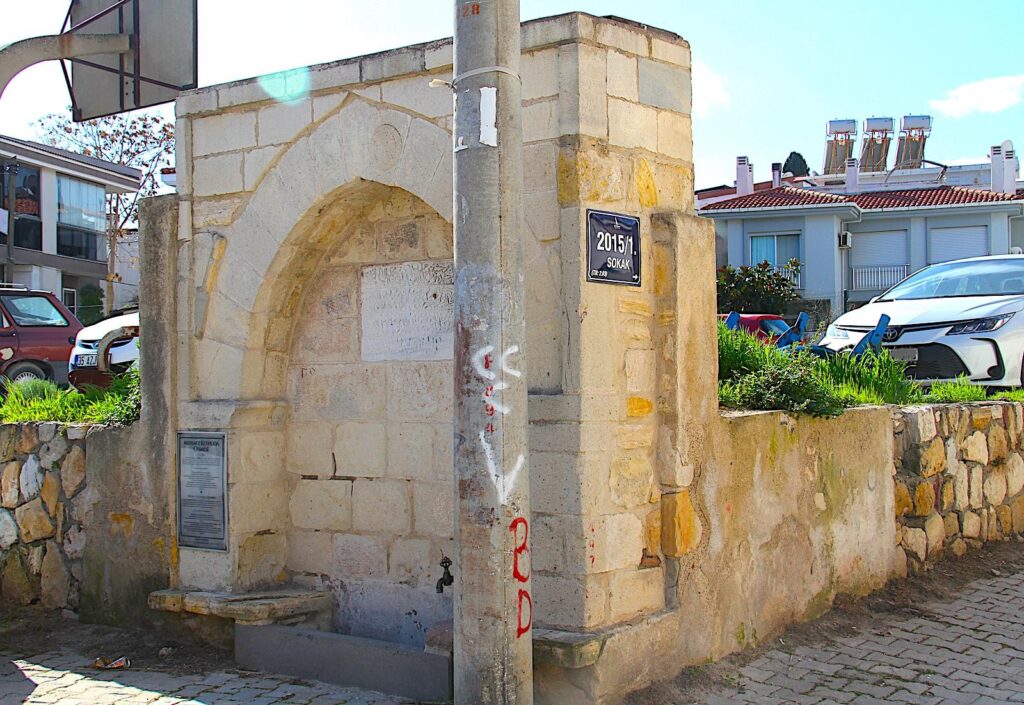
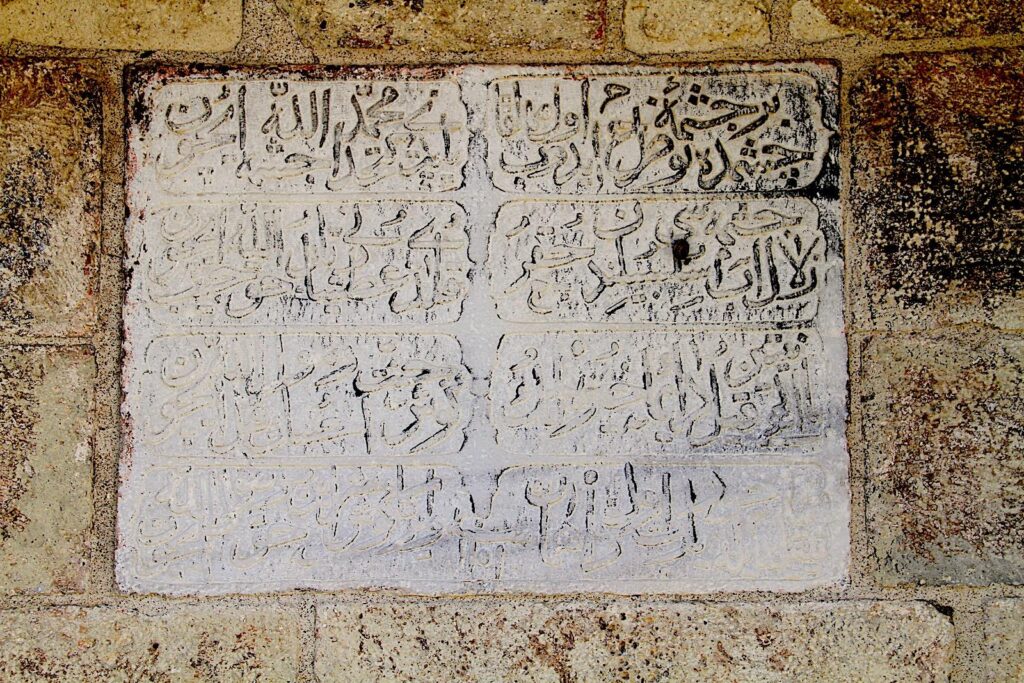
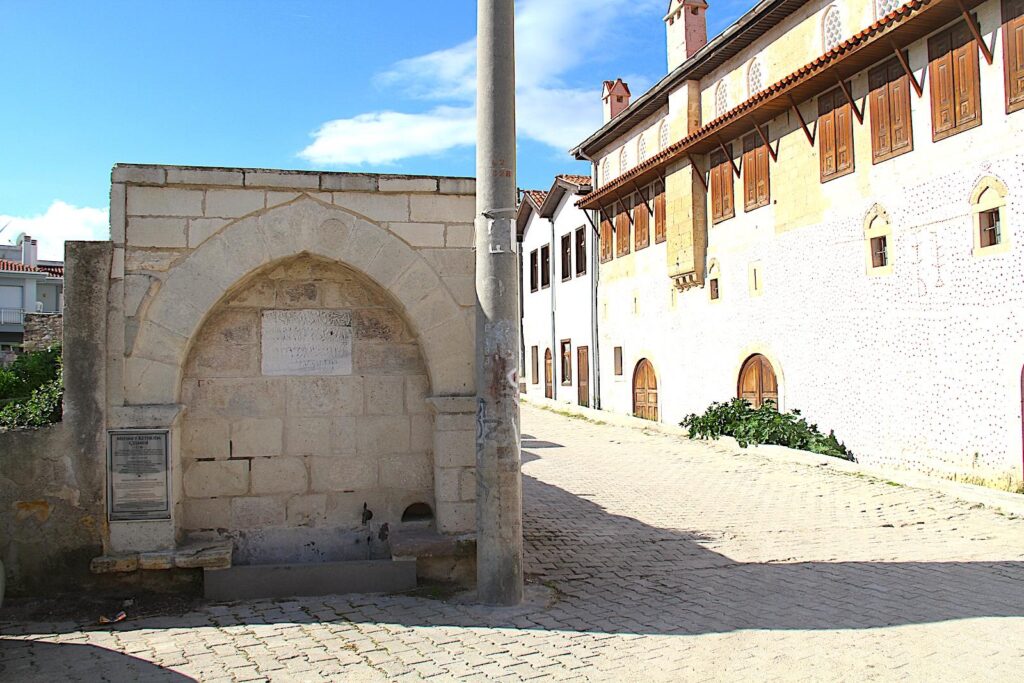
Ilyaszade Fountain (1780)
The Ilyaszade Fountain is located at the junctions of Sk. 2032/1005/2009. It is one of the best-preserved fountains in Çeşme. It is a freestanding fountain with dimensions 4.16m x 3.86m x 3.80m. According to the panels on each of the four façades, the İlyaszade Fountain was built in 1780 by Seyyid Muhammed, the son of Hafız İlyas. It was repaired in 1829 according to an additional panel at the right-side corner of the front façade Çeşme Municipality owns the fountain and has a conservation status as listed in July 1992 by the İzmir Regional Board for the Conservation of Cultural and Natural Assets.
The water supply system was originally part of the Hacı Memiş Ağa water system through terracotta pipes. The fountain is designed as a square with bevelled and concave curves at the corners. Niches frame the trefoil arches pointed on keystones rest on pilasters at each of the four façades. An alem (finial) on the dome, repair and inscription panels, eaves formed of profiled mouldings, spout stone, basins, Suluk basins and lantern hooks at each façade.
The construction material is mainly cut stone, voussoirs in white and red in the arches, and rubble stone in the dome. The motives are barely visible on the keystones of the front and right-side façade arches, spout stones and above parts of sulks. Conservation problems include spalling of the stone on the surfaces of voussoirs in red and darkening on cut stones in white. According to the records dated 1976, the basins and the dome’s plaster were renewed.
Attribution by Ahmet Karaçöl in the study states, “Built by SeyyidMuhammed, the son of Hafız İlyas according to the panels on each of four façades, and repaired in 1829 according to an additional panel at the right side corner of the front façade (Geyik 2007).”
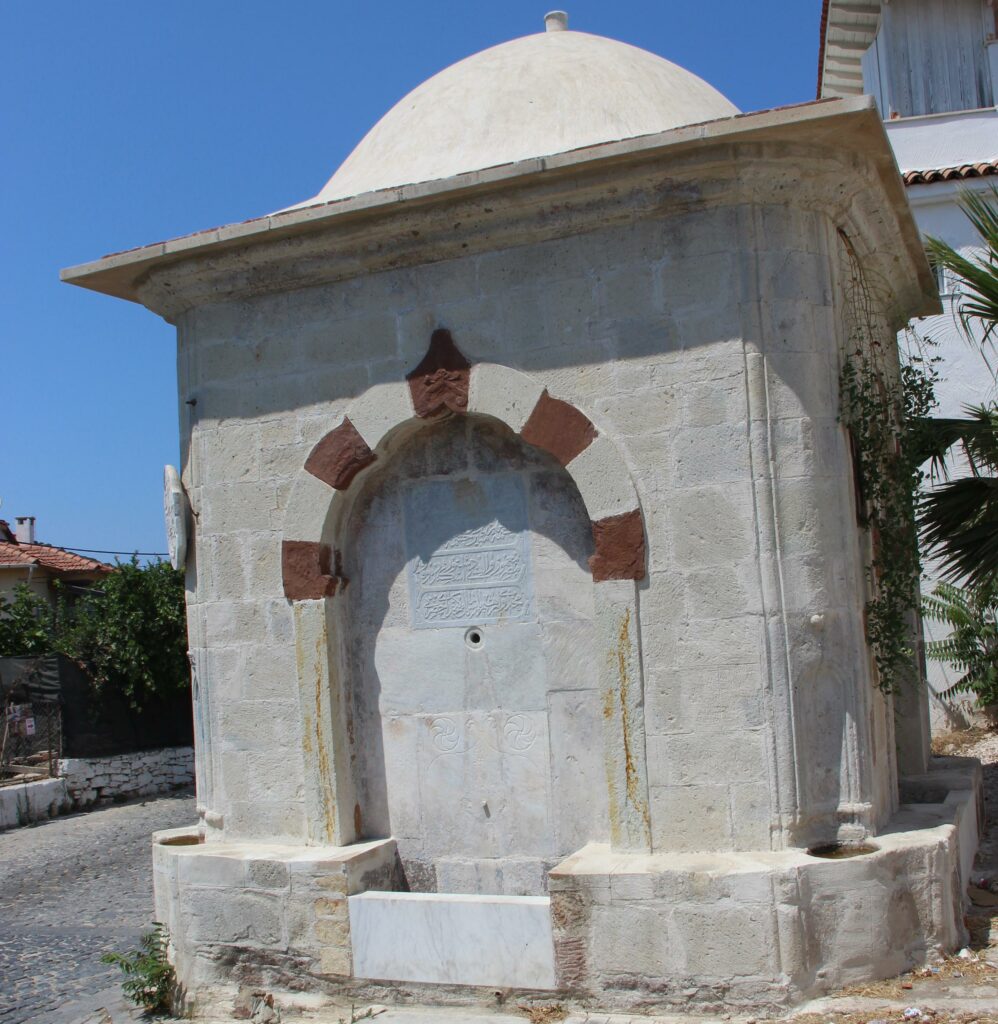
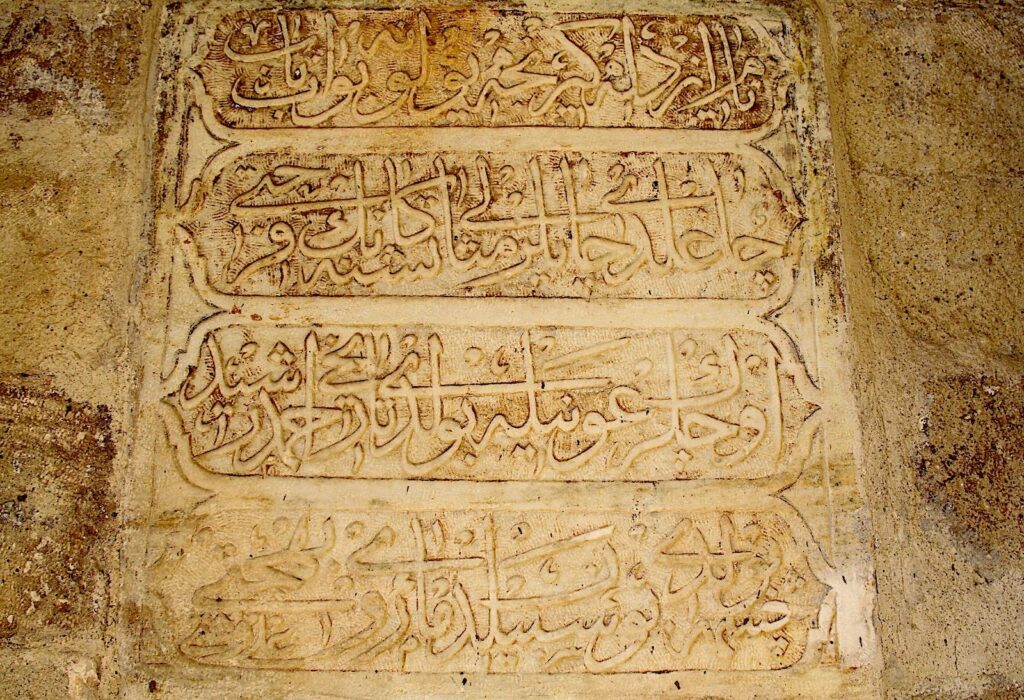
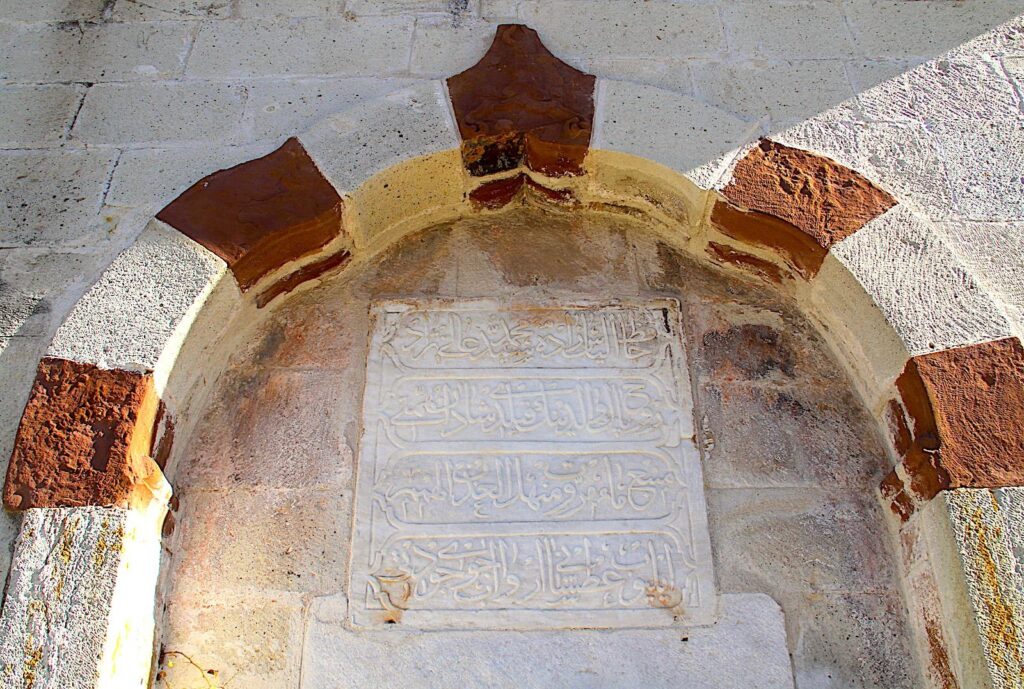
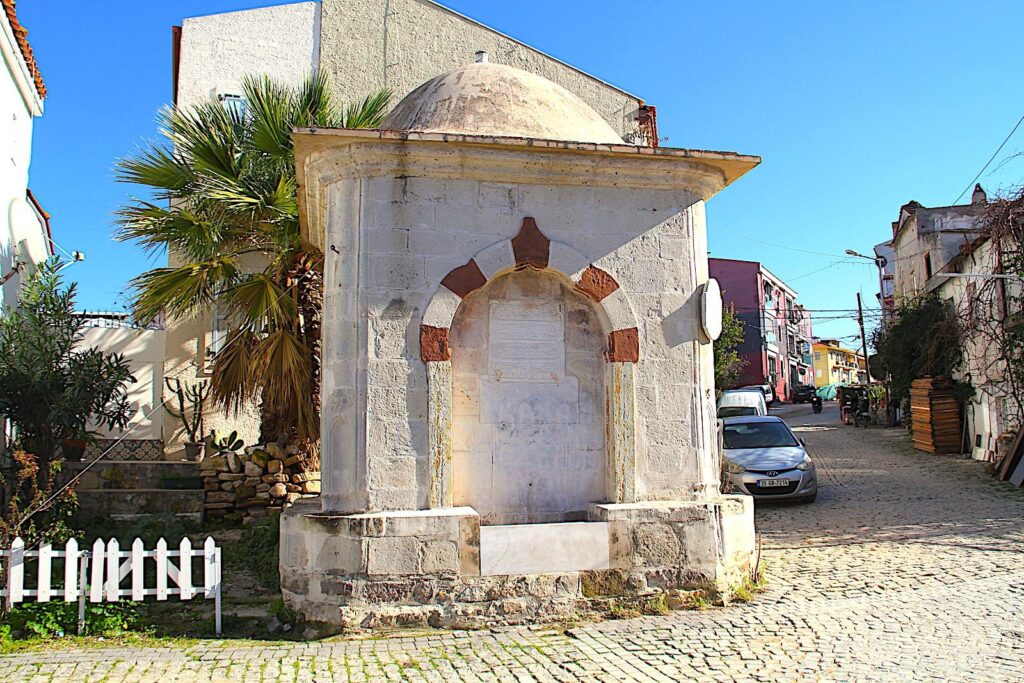
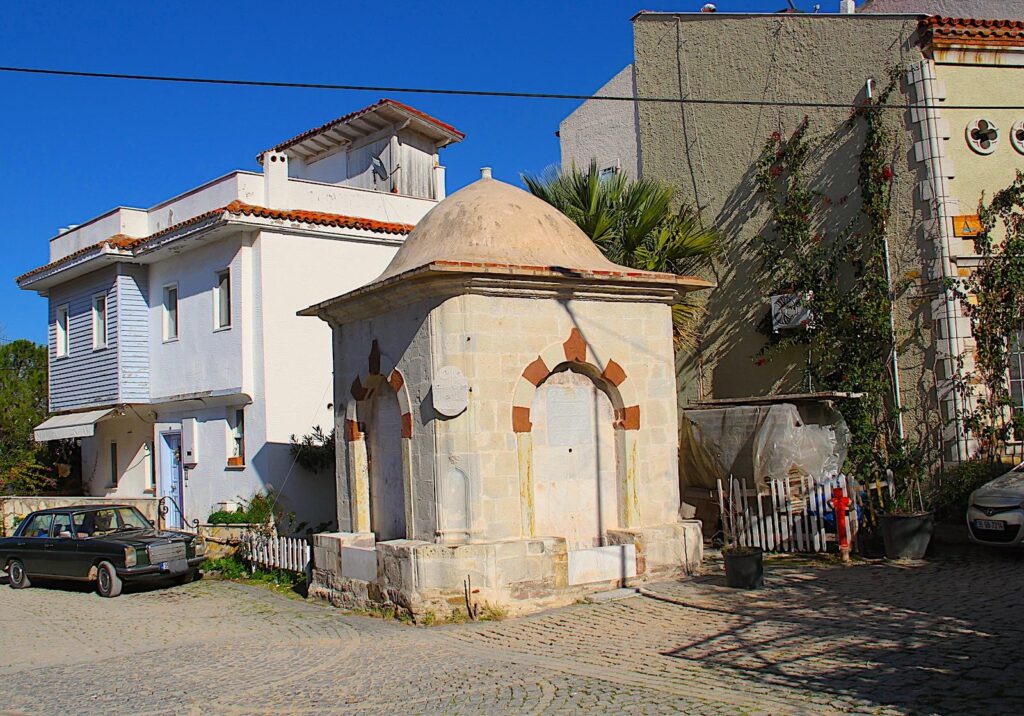
Hacı Mehmet Ağa Mosque Fountain (1832)
It is located on the wall of the Hacı Mehmet Ağa Mosque at the intersection of Sk. 1002 and Sk. 1005. It was built by Hacı Mehmet Ağa in 1832, according to the inscription panel of the mosque. The fountain was listed in July 1992 with the İzmir Regional Board for the Conservation of Cultural and Natural Assets number 3889 and owned by the General Directorate of Pious Endowments.
The fountain was initially connected to the Hacı Memiş Ağa water system with terracotta pipes. The fountain is rectangular, measuring 3.43 metres in width by 1.98 metres in height (2.56 metres together with a basin). It has a barrel vault with a façade composed of a niche frame, semicircular arch and profiled vertical moulding above. The construction material is rubble stone, with cut stone in the arch and pilasters. The cement plaster application on the left side has missing voussoirs and pilasters, the basin is below ground level, and the spout is inactive.
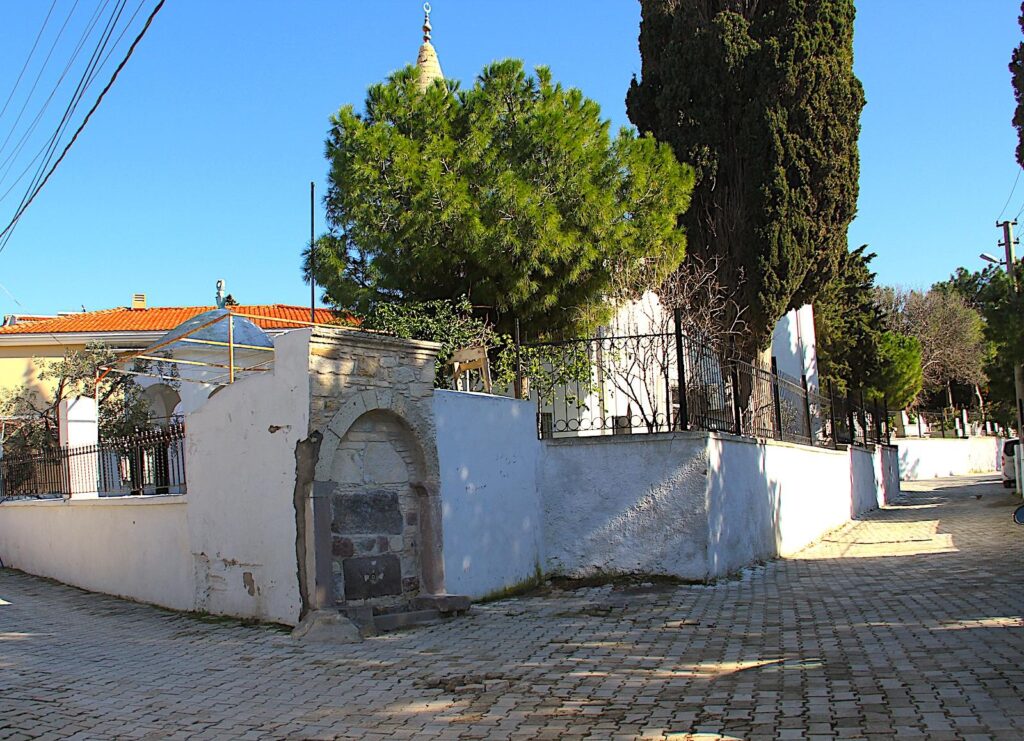
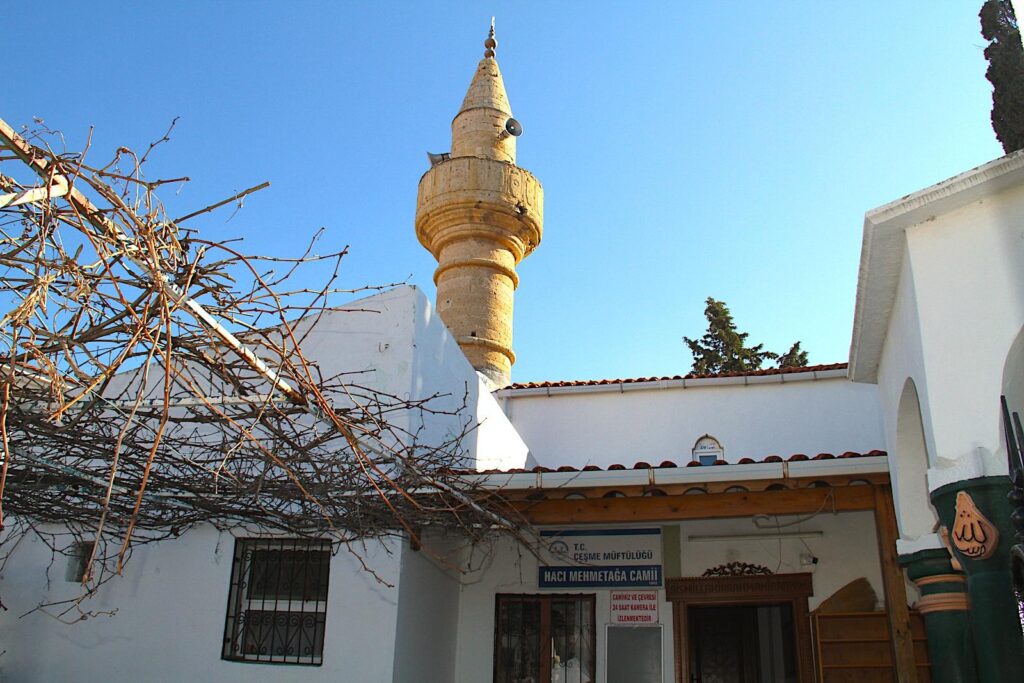
Çatal Fountain (Unknown date)
The Çatal Fountain (Fork Fountain) is located at the junction of Sk. 2051/2042 (opposite Çeşme amphitheatre). It is now a freestanding fountain with 3.30m x 2.33m x 2.71m dimensions, but before 1990 would not have been. It was relocated in the 1990s to allow for the building of a residential block and listed for preservation in July 1992. It is currently in the car park area and used as storage/display by an adjacent florist.
Çeşme Municipality owns the fountain and has a conservation status as listed in July 1992 by Number 1 İzmir Regional Board for the Conservation of Cultural and Natural Assets (decision no. 3889). It would have been connected to the water supply system of Hacı Memiş Ağa. The façade is framed with two arches with a semicircular profile resting on pilasters, which are, in turn, resting on the stone plates of jug shelves.
The construction material is rubble stone on the rear façades and on the front façade cut stone voussoirs and pilasters. Apart from the profiled impost stones, there are no ornamentations, and their original features have been missing since the transfer of location. On top, it has a dome with an oval plan. The water collecting chamber is frequently filled with rubbish and surrounded by parked cars and garbage bins.
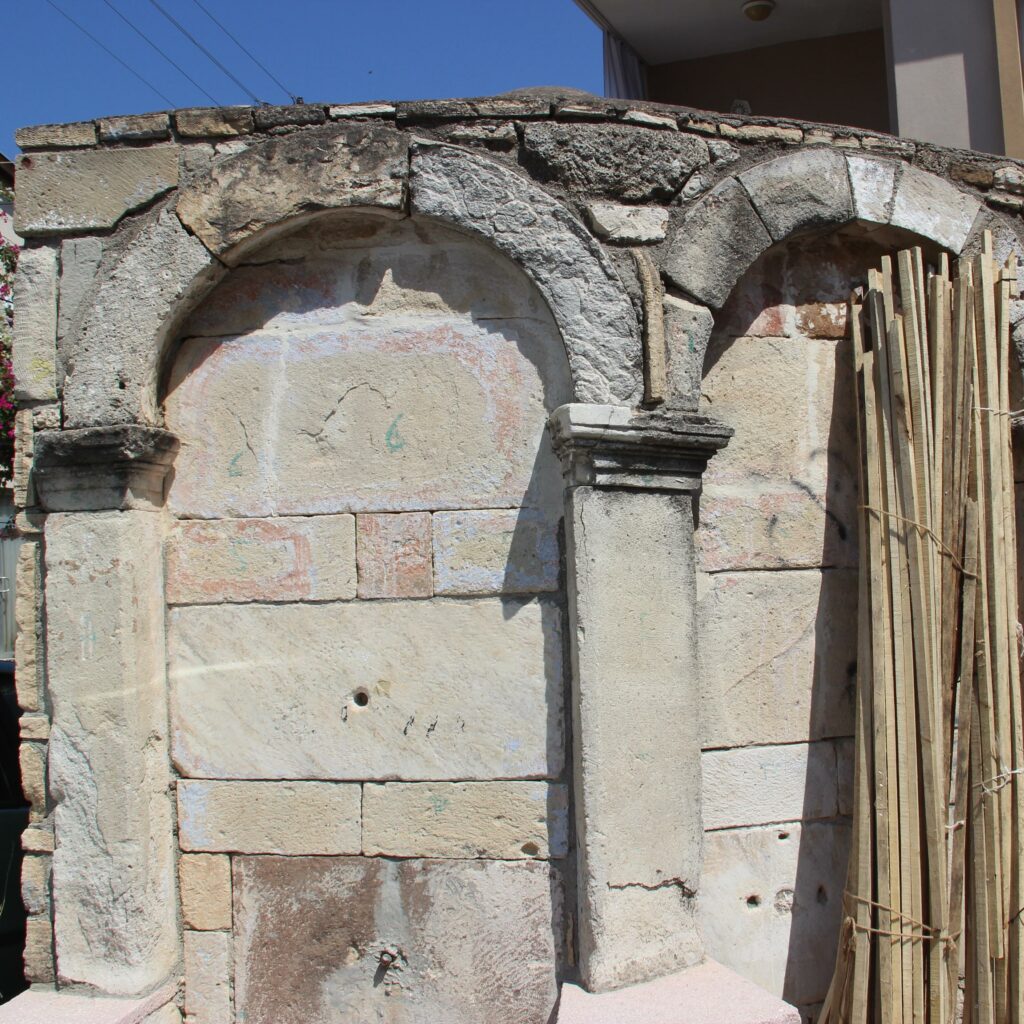
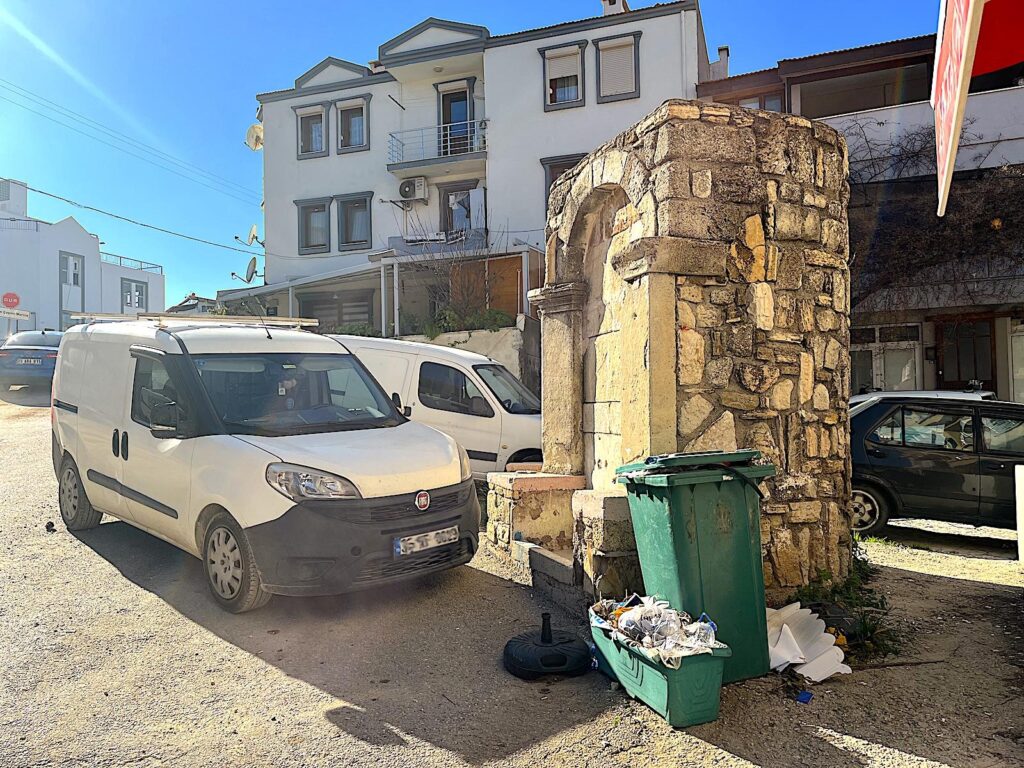
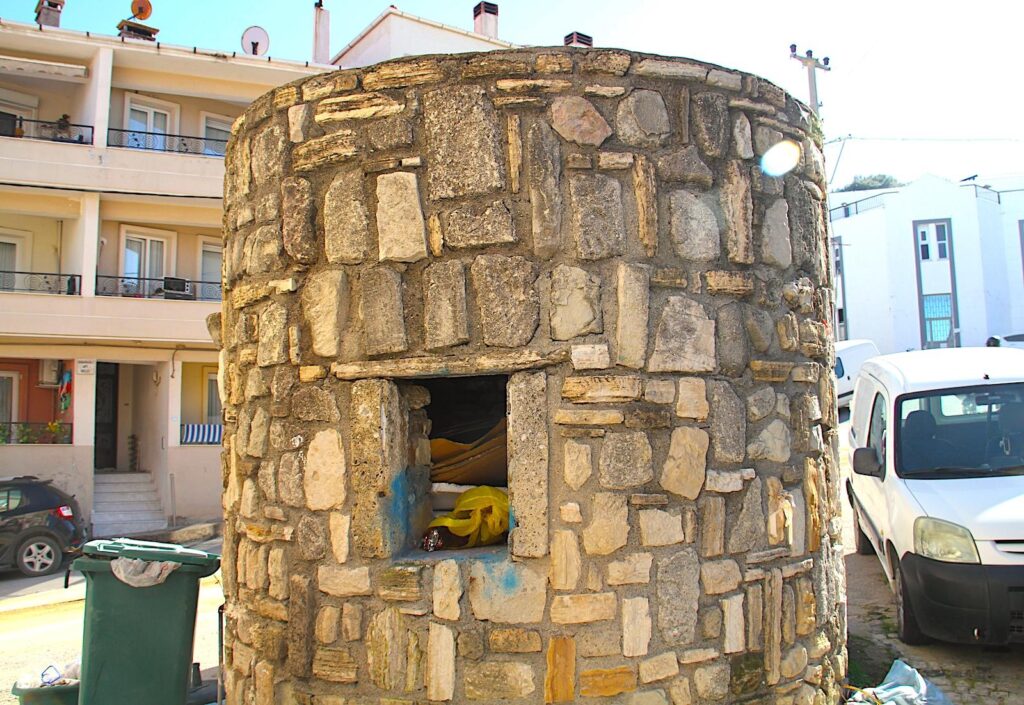
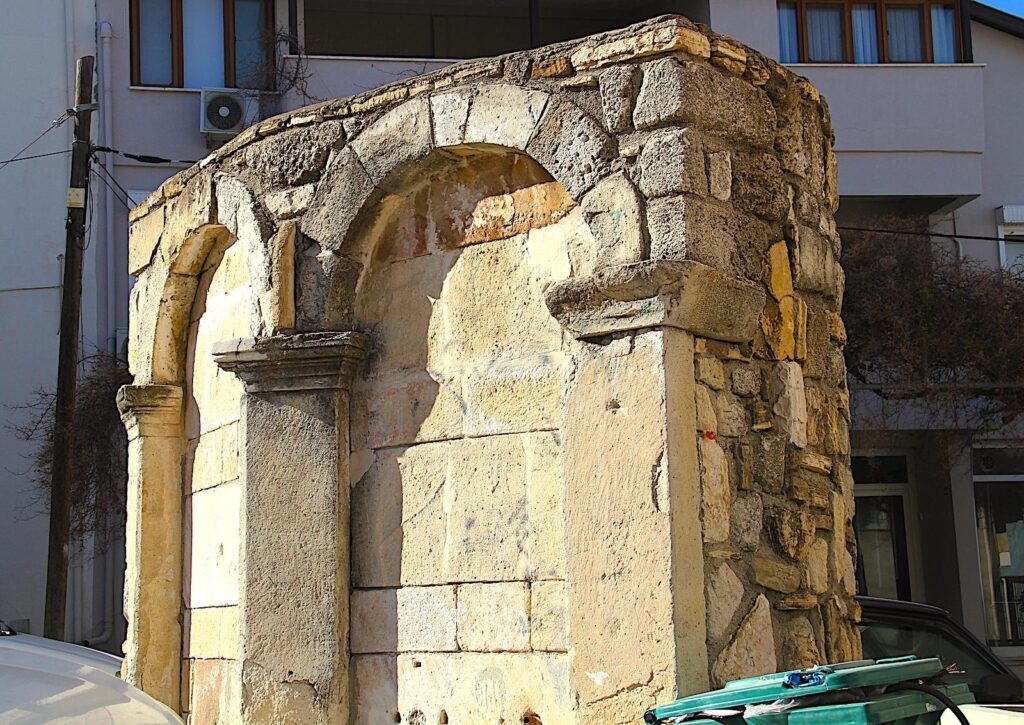
Maksem on sk. 2051
It is located in the corner of a carpark near Çeşme Amphitheatre on the junction of sk. 2051/2046 formerly Mehmet Ağa Street. Though some sources list it as such, there is no evidence that this is a fountain, but a fine example of a maksem and, therefore, is included alongside the fountains of Çeşme.
A maksem, in Ottoman times, was a crucial infrastructure component for water distribution. It served as a water reservoir and distribution hub, regulating water flow from aqueducts or cisterns to fountains, hammams, mosques, and households. These structures were often strategically located at high points to allow gravity-fed water distribution. Architecturally, they were usually built domed or cubic, sometimes adorned with inscriptions and decorative elements. The water tank, neglected and dilapidated with its rubble stone and brick-woven dome structure, is difficult for passers-by to notice. Due to the lack of any inscription, no information about the builder and the year of construction appears to be known.
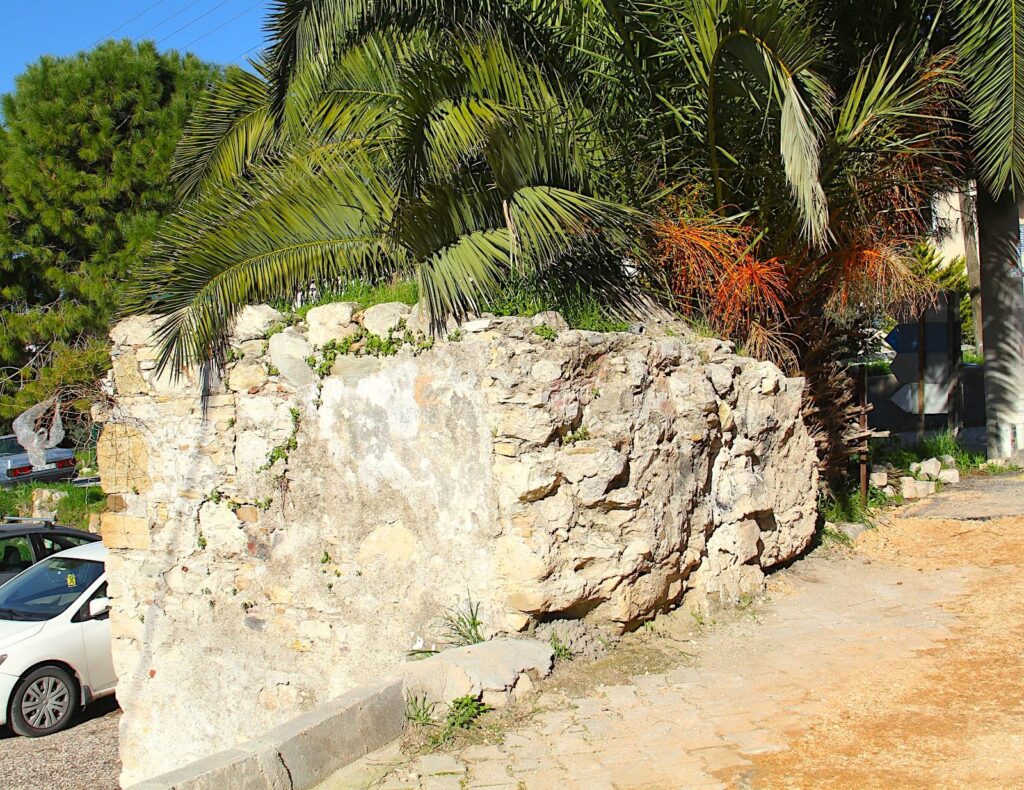
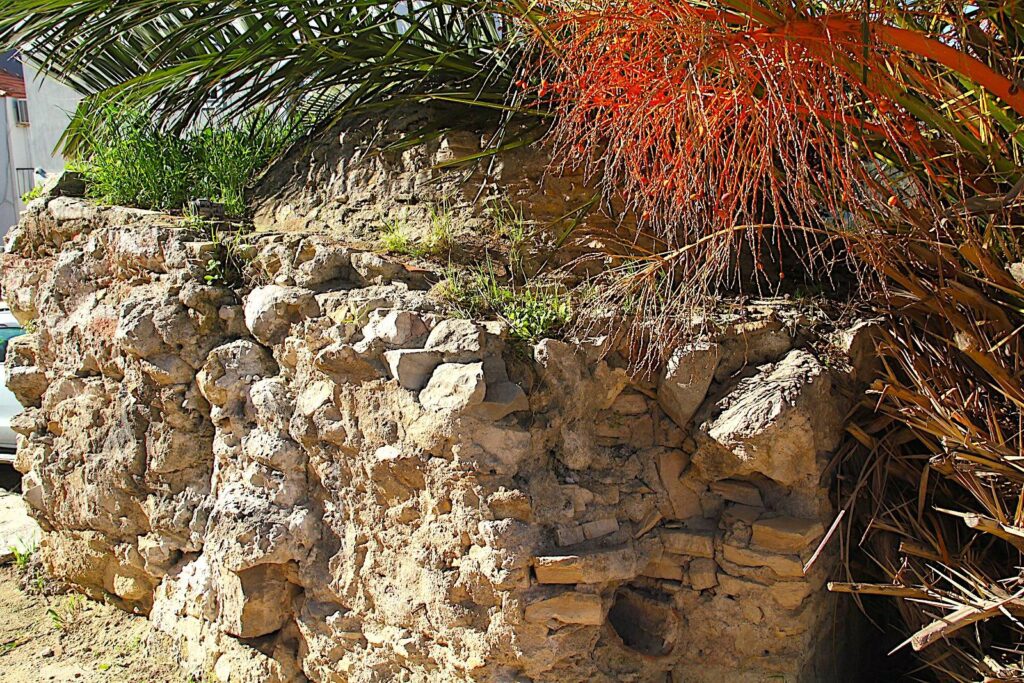
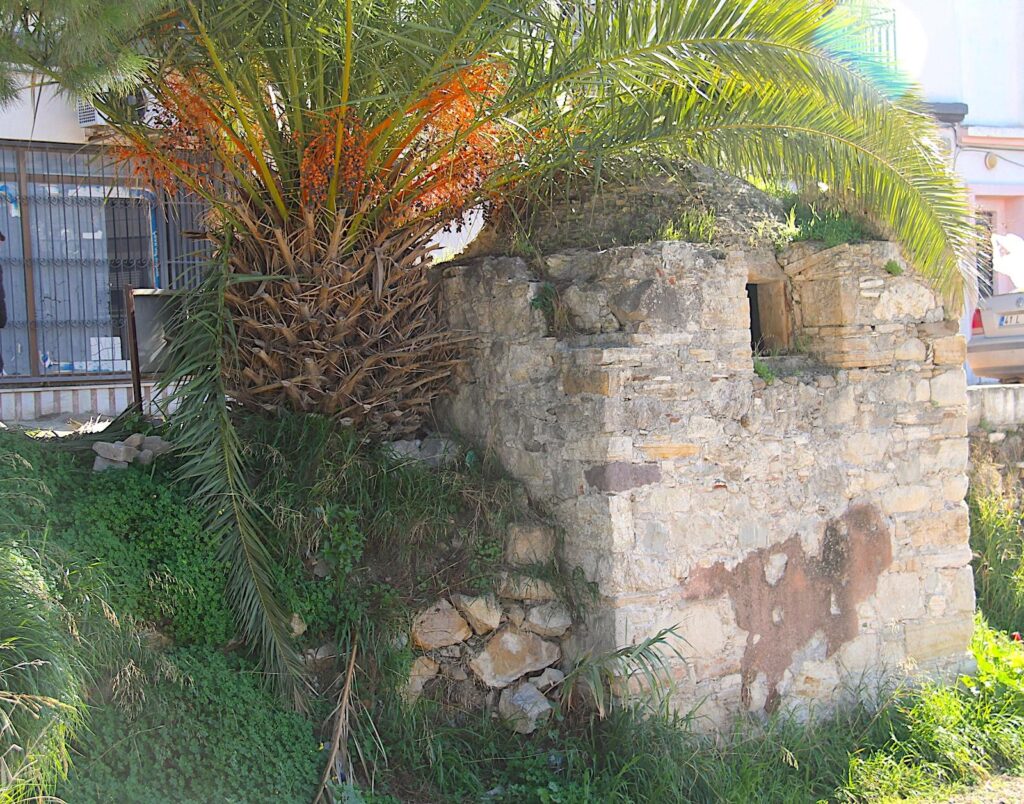
Hamaloğlu / Hafize Rabia Hatun Fountain (1851)
The Hamaloğlu Fountain, also known as the Hafize Rabia Fountain, is located at the junction of Sk. 1021 and Sk. 2032 (previously known as Mufti Street and Hamal Street) on the corner of the Hacı Mehmet Ağa Mosque 18th Century Hazîre (walled) cemetery. The fountain is freestanding with a title deed of 92 square metres and has dimensions of 4.25m x 3.40m x 3.50m. Owned by the General Directorate of Pious Endowments, the fountain was listed for preservation in July 1992 and restored in October 2015.
The fountain was built in 1851 by Hacı Rabia Hatun, according to the inscription panel on the front façade. Initially, the fountain was connected to the Hacı Memiş Ağa Water system through metal (likely lead) pipes. In another period, water was provided with a pipeline of three terracotta pipes set vertically, with a separation wall built in the chamber’s south/west direction. Today, it is connected to the network with galvanised pipes, but the function is currently inactive. The original maintenance window was closed, and a second window was opened with the chamber plastered to collect more water.
The fountain has a cut stone facade, red and white arch stones, a rubble masonry dome, and an Ottoman inscription in a depicted jug on the façade arch keystone. Tulip motives are on either side of the spout stone. Three façades are arched except for the north facade (facing the cemetery). There is a marble inscription and a marble mirror stone under each arch.
The municipality plaque inscription reads: “Hamaloglu Hafize Rabia Hatun Fountain was constructed by Hafize Rabia Hatun in 1267 (Hegira calendar), 1851 (Gregorian calendar). By the leadership of the Association of Cesme Hotels, it was restored with the support of Izmir Zone Foundations Directorship and Municipality of Cesme, sponsorship of Dear Rabia Kalyoncu and Dear Mete Kalyoncu and Umart Architecture October 23 2015.”
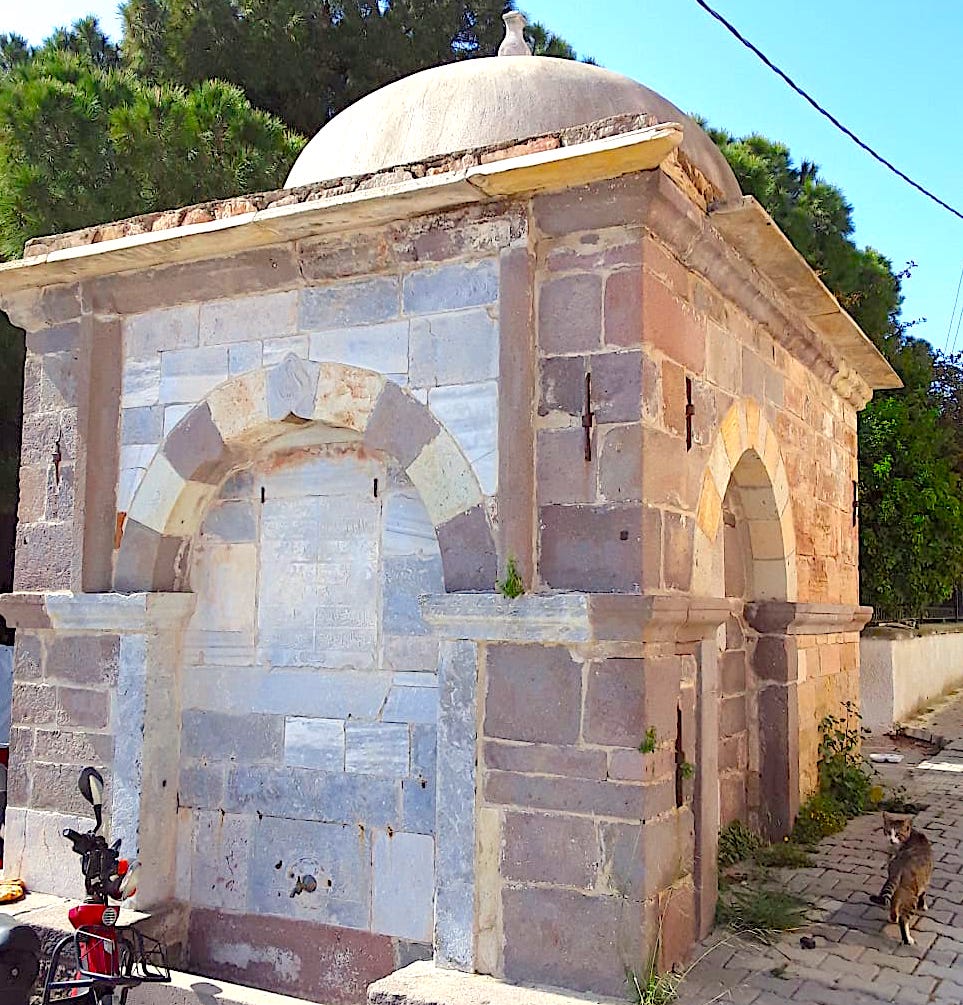
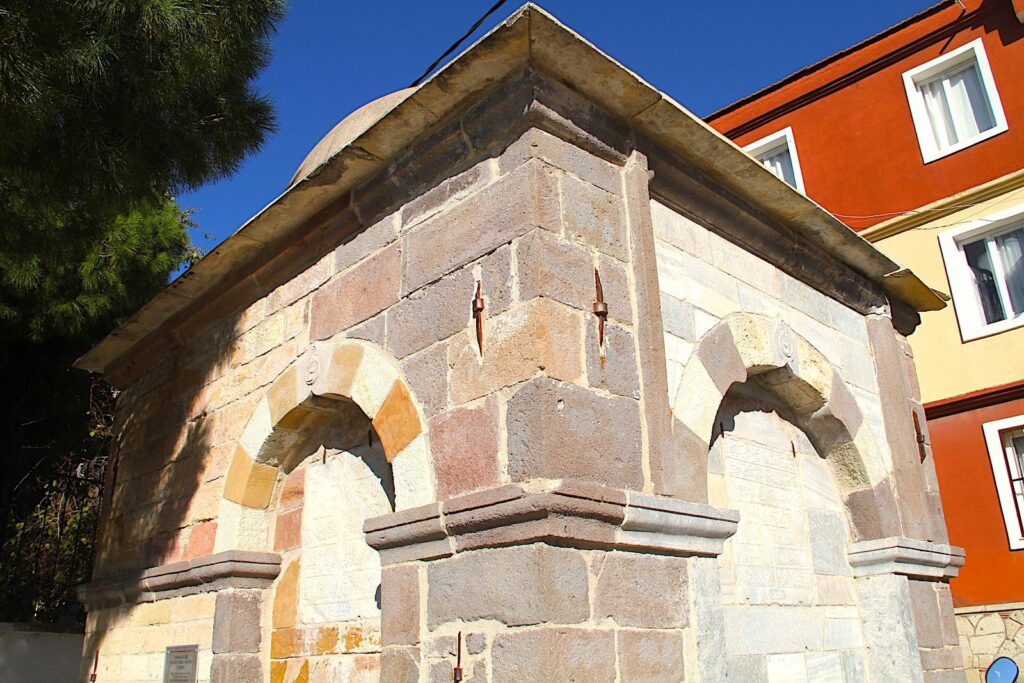
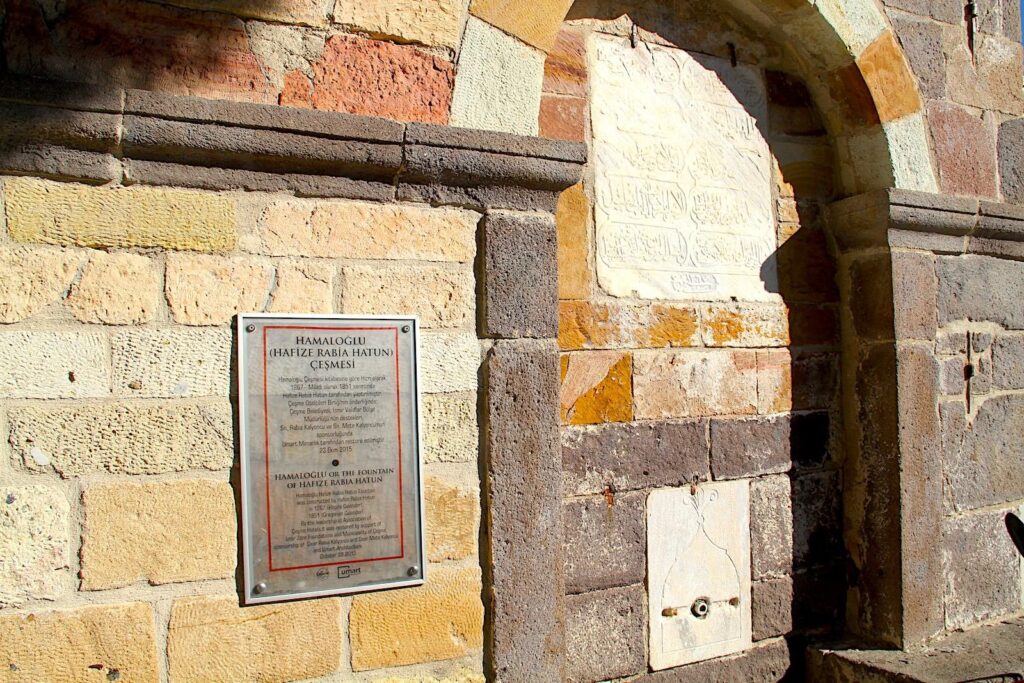
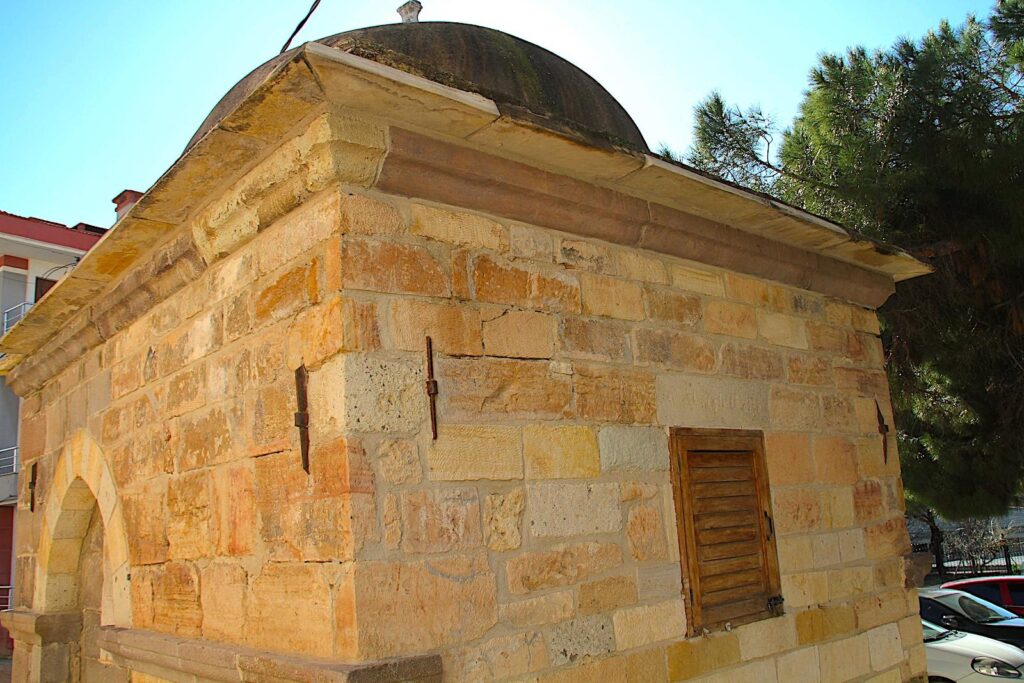
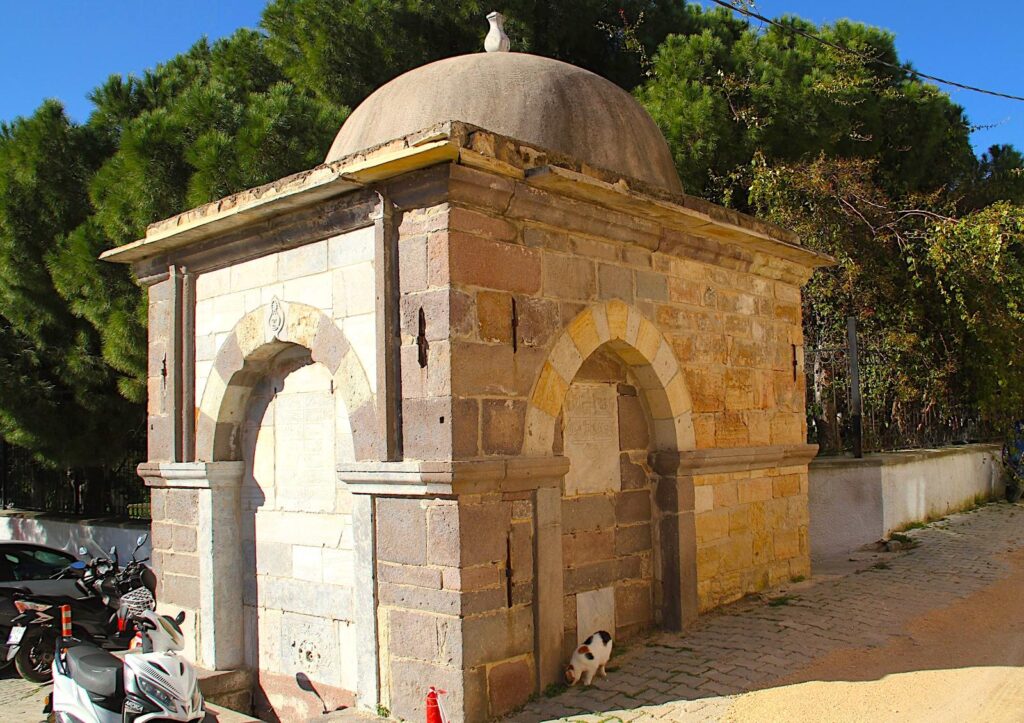
Kabadayi Fountain (1839)
The Kabadayi Fountain is located at the junction of Sk. 1005 and Sk. 1043 (formerly Akoğlan Street and Kabadayı Street). According to the inscription panel, the fountain was built by Muhacir Kabadayı Hüseyin Ağa in 1839. It is loosely attached to the adjacent decrepit building and has the dimensions of 4.60m x 3.33m x 3.35m. This fountain of Çeşme is owned by the General Directorate of Pious Endowments and was listed for preservation in July 1992.
It is constructed with a cut stone facade, columns and arches, and a rubble masonry dome covered in plant growth. It is one of the most artistic fountains in the region. The curves given to the stone in its arched structure, the marble columns on the edge of the mirror stone, and the ornate marble blocks on the edges of the fountain are remarkable.
The water supply system was initially connected to Hacı Memiş water through the collecting chamber. It has a connection to the water system with galvanised pipes but is currently inactive. The fountain needs repair of pilasters, iron stretching bars, and the replacement of the missing left-side jug shelf. This masterpiece is at risk of extinction today. The dome of the fountain is scattered and covered with grass. The stone slabs have started to separate from each other, probably due to the work carried out on the building behind.
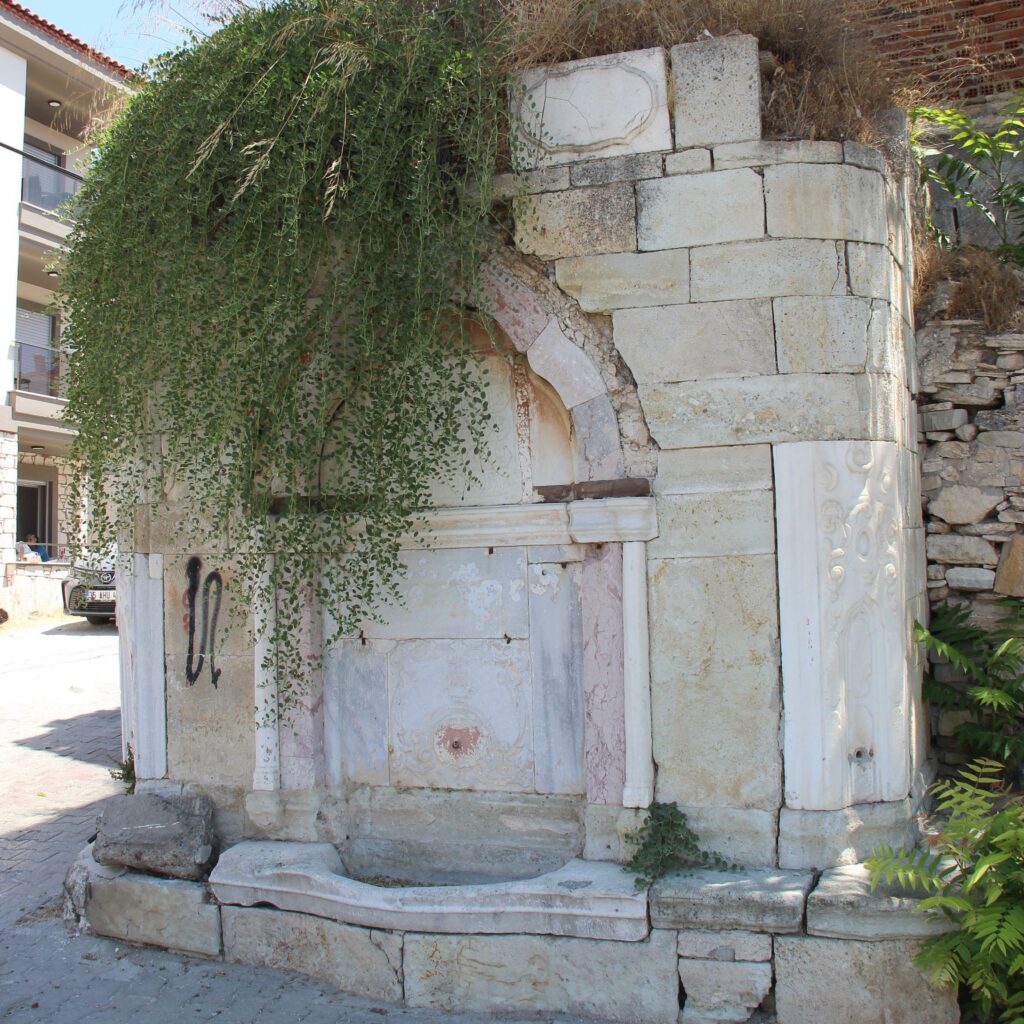
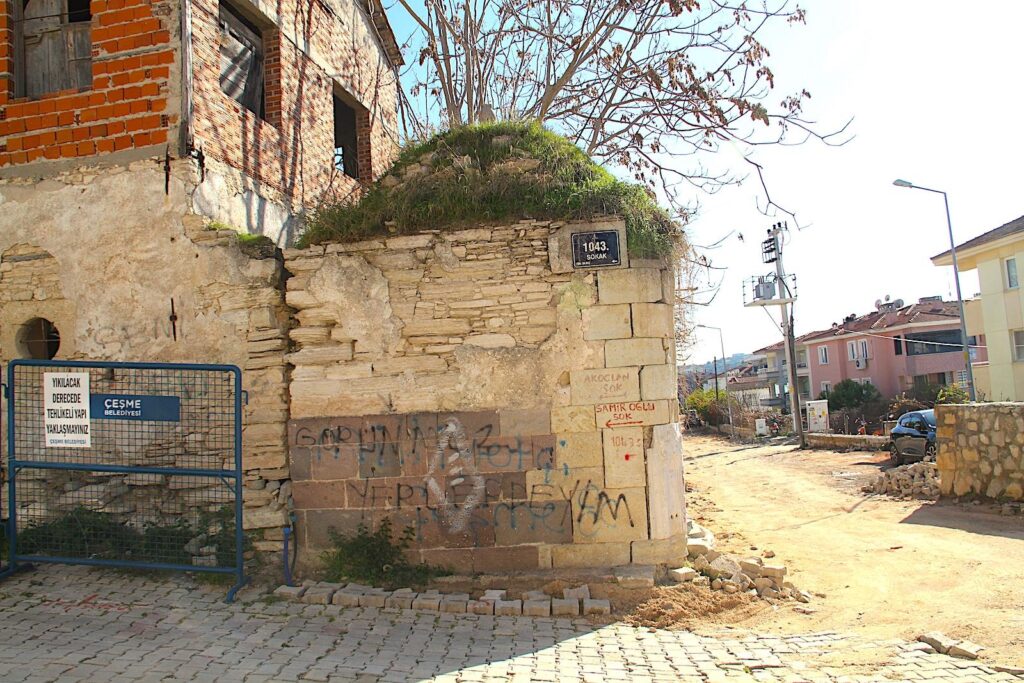
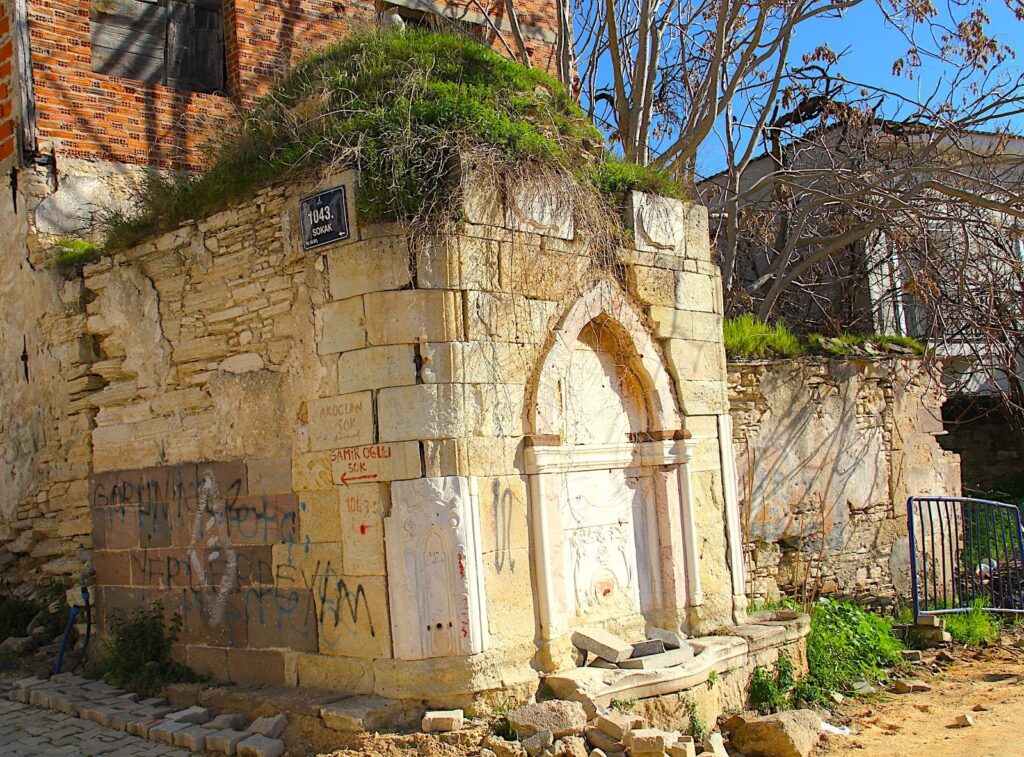
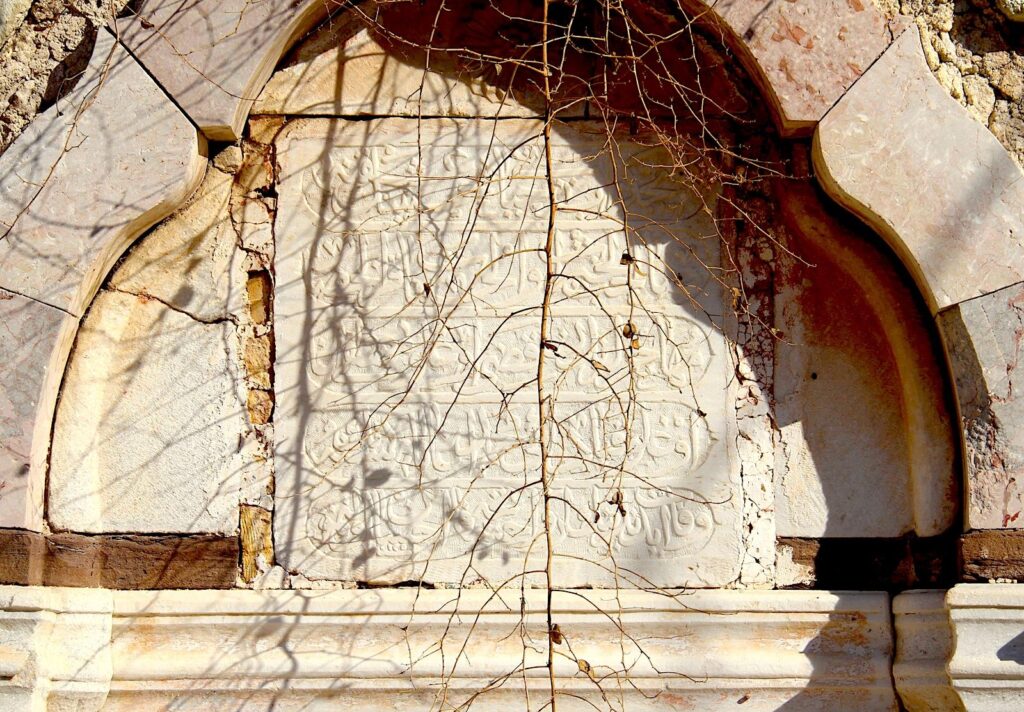
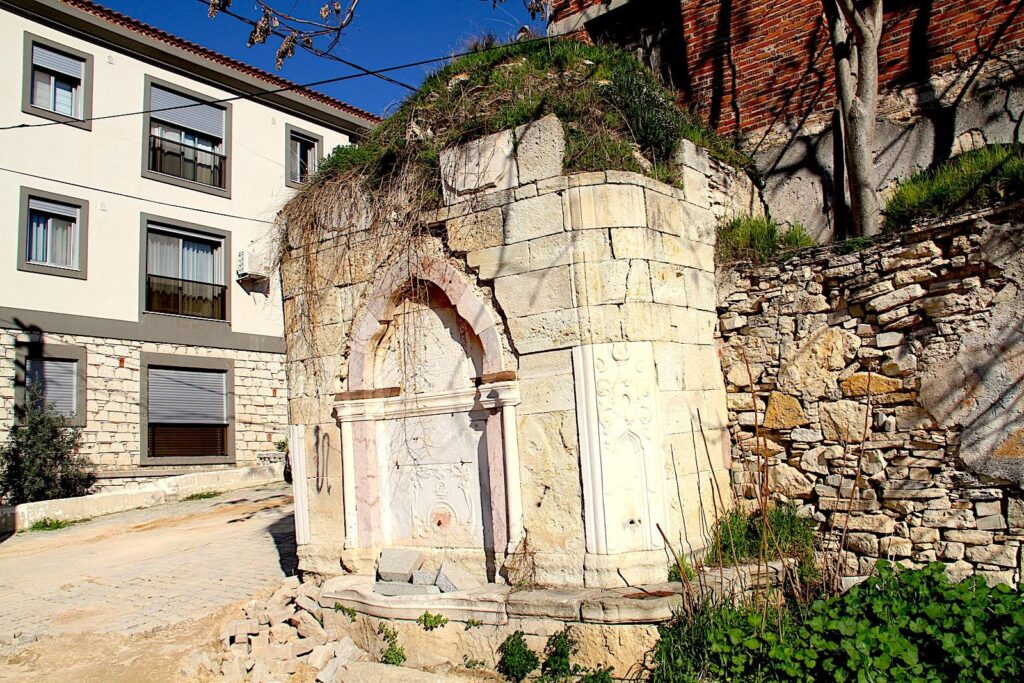
Kaymakam Fountain (1886)
The Kaymakam Fountain was built in 1886 by Kaymakam Sadık Bey and is now located on Sk. 1065 at the corner of Sk. 1015. It is a freestanding fountain with dimensions of 3.70m x 3.11m x 3.05m. The General Directorate of Pious Endowments owns the fountain, which was listed for preservation in July 1992. It was renovated and relocated in 1986 due to the construction of the Çeşme harbour road.
The fountain has cut andesite stone on all facades, slate stone eaves, rubble interior, and a cement plastered dome since transfer. The water supply system was originally by Hacı Memiş Ağa Water through lead pipes. At present it is connected to the network with galvanised steel pipes, with water dispensed from a single spout on the front façade.
The municipality plaque inscription reads: “Kaymakam Sadik Bey Fountain was constructed by Kaymakam Sadik Bey in 1303 (Hegira calendar), 1886 (Gregorian calendar). By the leadership of the Association of Cesme Hotels, it was restored with the support of Izmir Zone Foundations Directorship and Municipality of Cesme, sponsorship of Dear Mehmet Akpinar and Umart Architecture October 23 2015.”
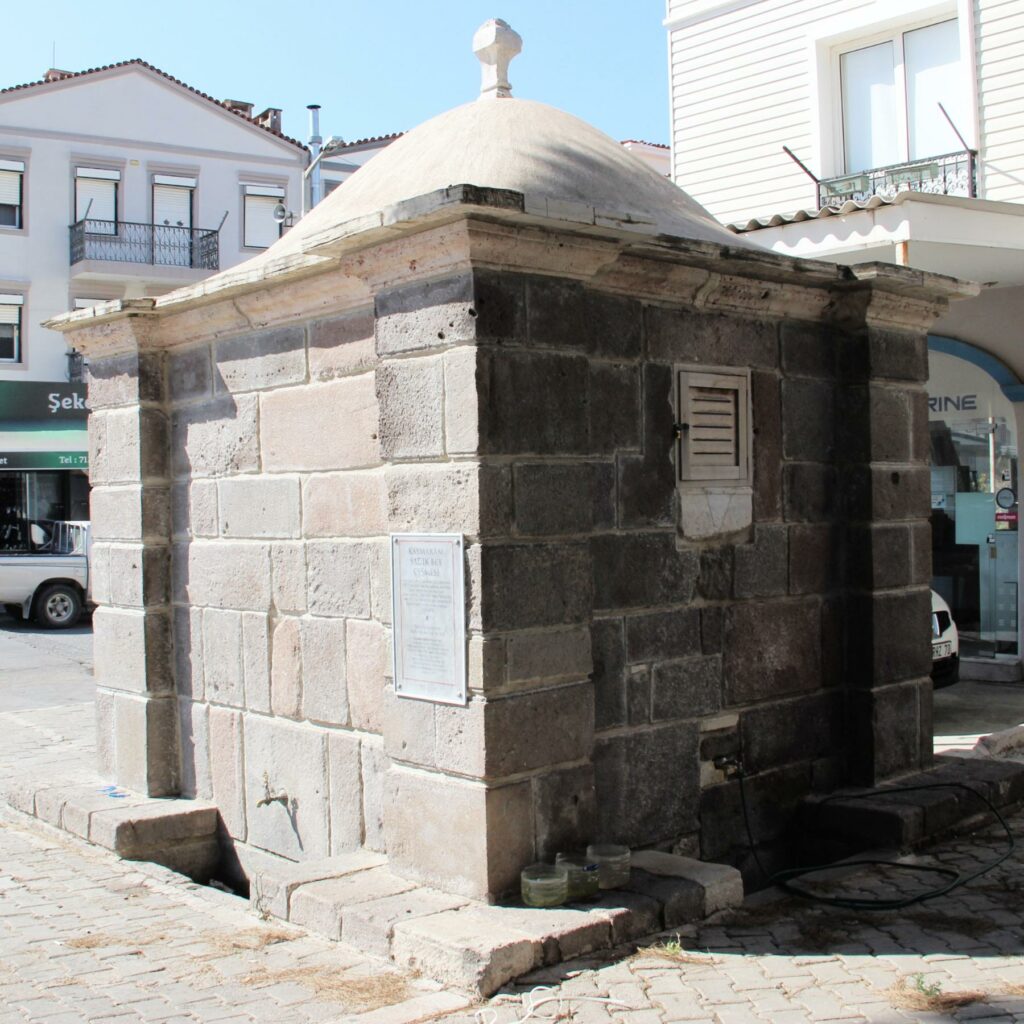
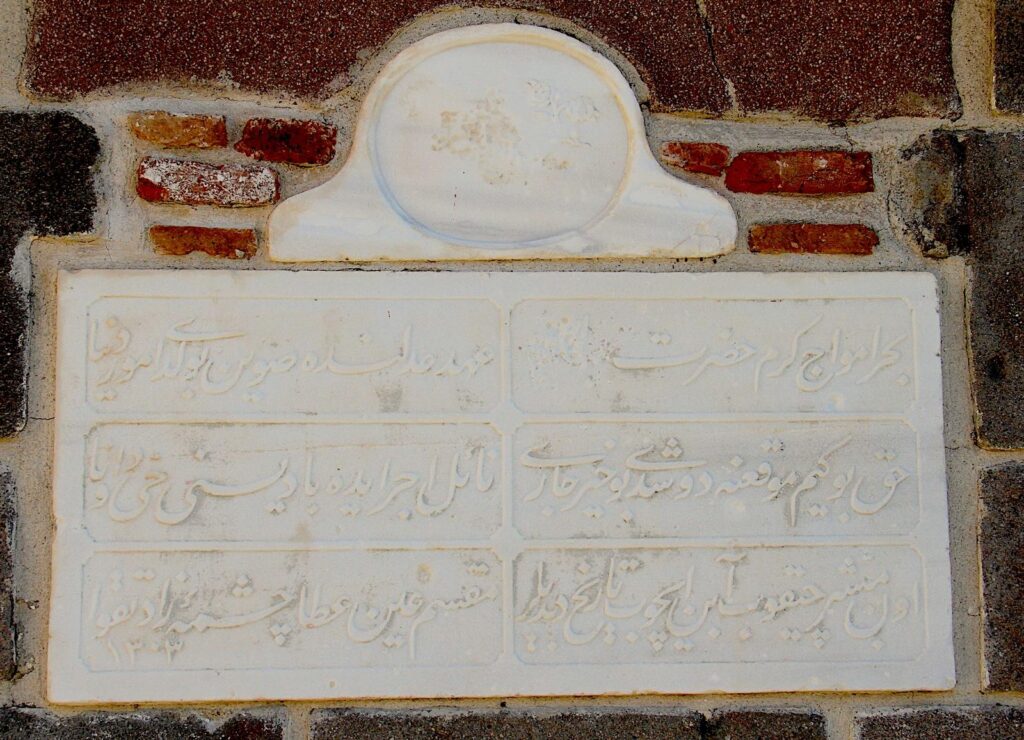
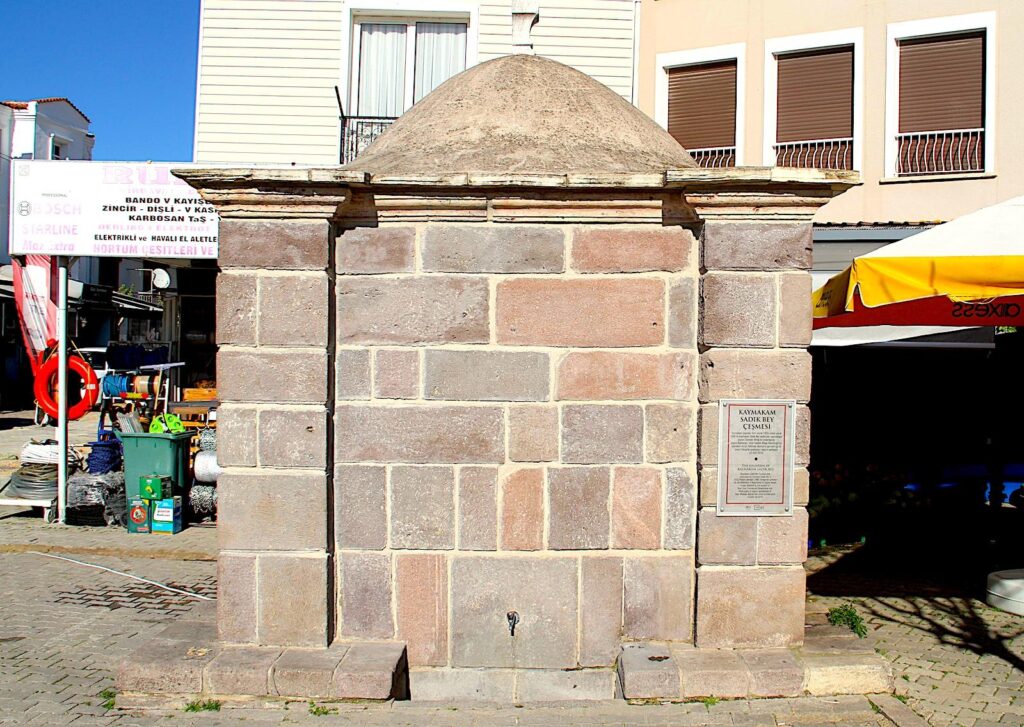
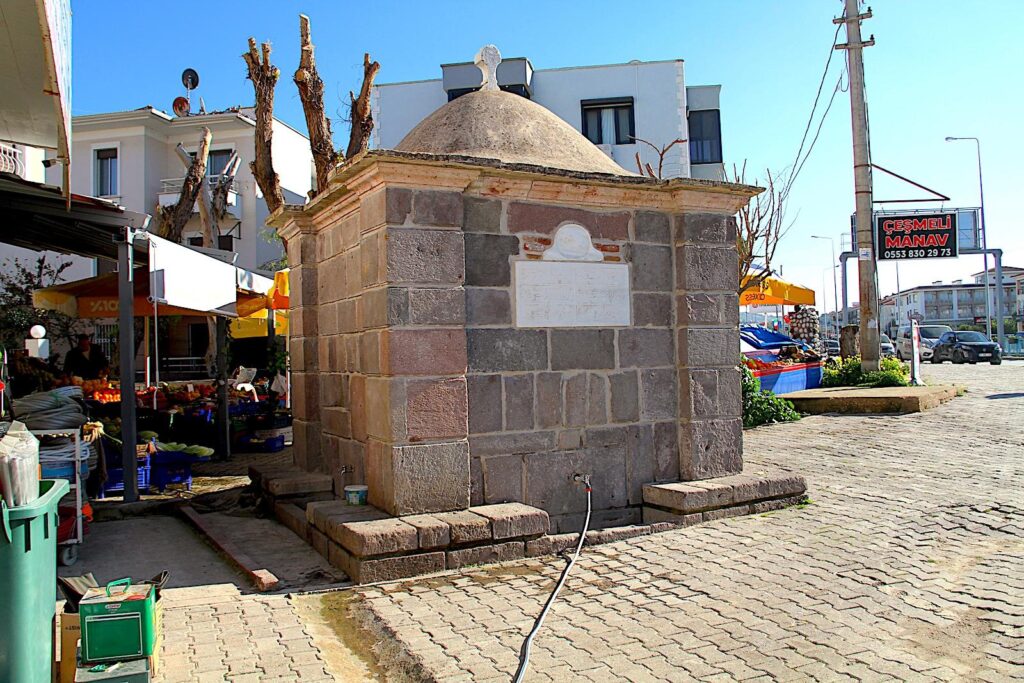
Girayhanoğlu Fountain (circa 1701)
According to the plate on the fountain, it was built by Hacı Selim Girayhanoğlu Kalgay Girayhan, one of the sons of the Crimean Khan, in 1683. It is a square marble fountain consisting of three parts; the upper is decorated with geometric decorations and flower branches, and the middle section has a short verse with the main decorations, including traditional oyster motifs, bowls of figs and flower decorations. Finally, The lower section has the fountain trough with two ornaments and geometric motifs. The fountain is located on a small green on Atadağ Caddesi opposite Çeşme Marina; no title deeds attest to its historical presence in this location; it appears to be so extensively restored that it looks like a modern replica.
No date is specified in any place besides the fountain’s information board with the date of “Islamic Hijri calendar 1112”. This should be calculated as the Gregorian equivalent of 1701 (possibly 1700), but it is written as “1683”. In addition, the name of Kalgay Giray Han written on this board is probably also wrong. Kaplan Giray Khan was the son of Beyzade Sultan and Selim Giray Khan. Selim Giray Khan was born in 1680 while in exile in Rhodes and became the Khan of Crimea in 1706.
Therefore, the dates do not appear to correspond. After his khanate, which lasted 1 year and 10 months, he was released in 1708 and exiled to Rhodes. He became the Crimean Khan for the second time in 1713 and the third time in 1730, and after he died in 1738 on Chios Island, where he was dismissed and sent in 1736, he was buried in Çeşme per his will. Alternatively, the dates could correspond to Hacı II Giray (1644 – 1689), who reigned briefly between 1683-4 and participated in the Seige of Vienna in 1683.
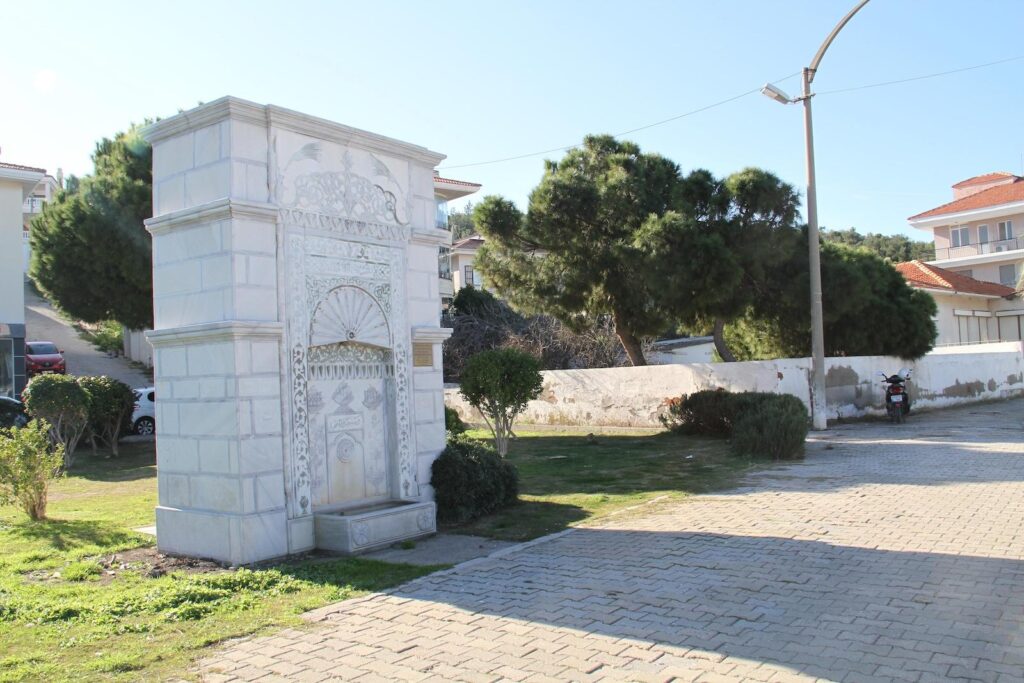
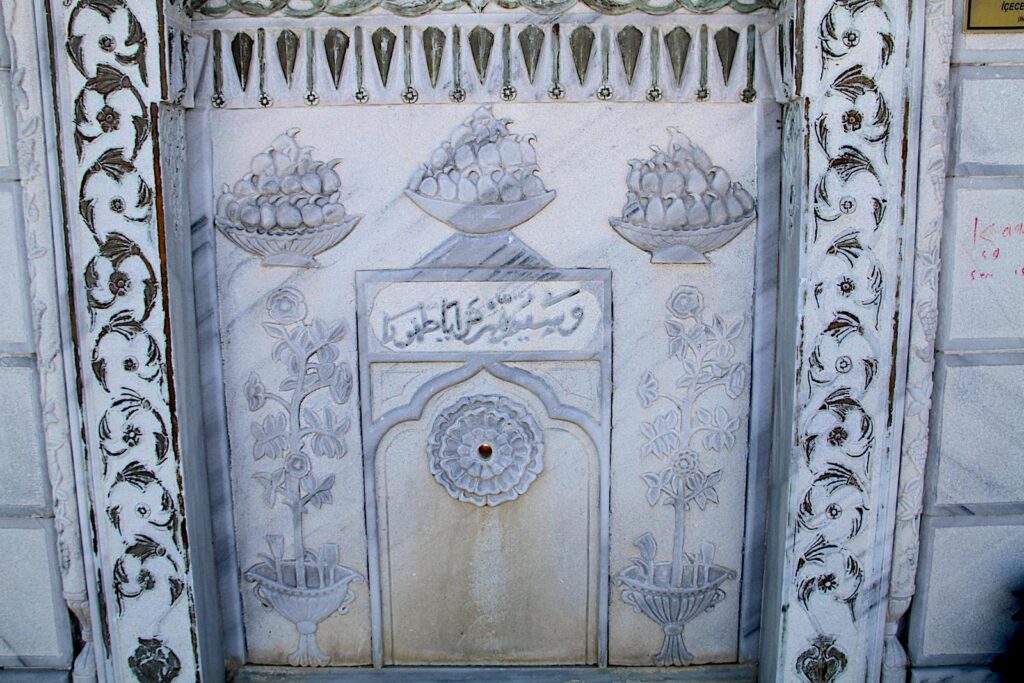
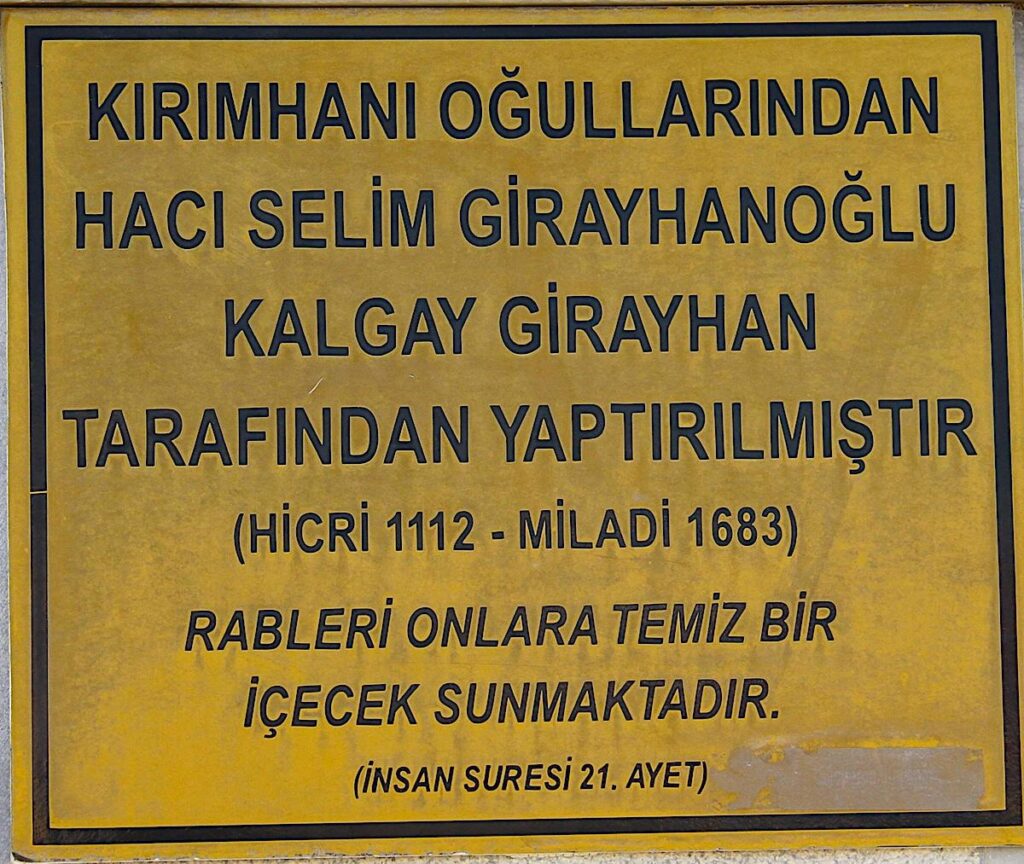
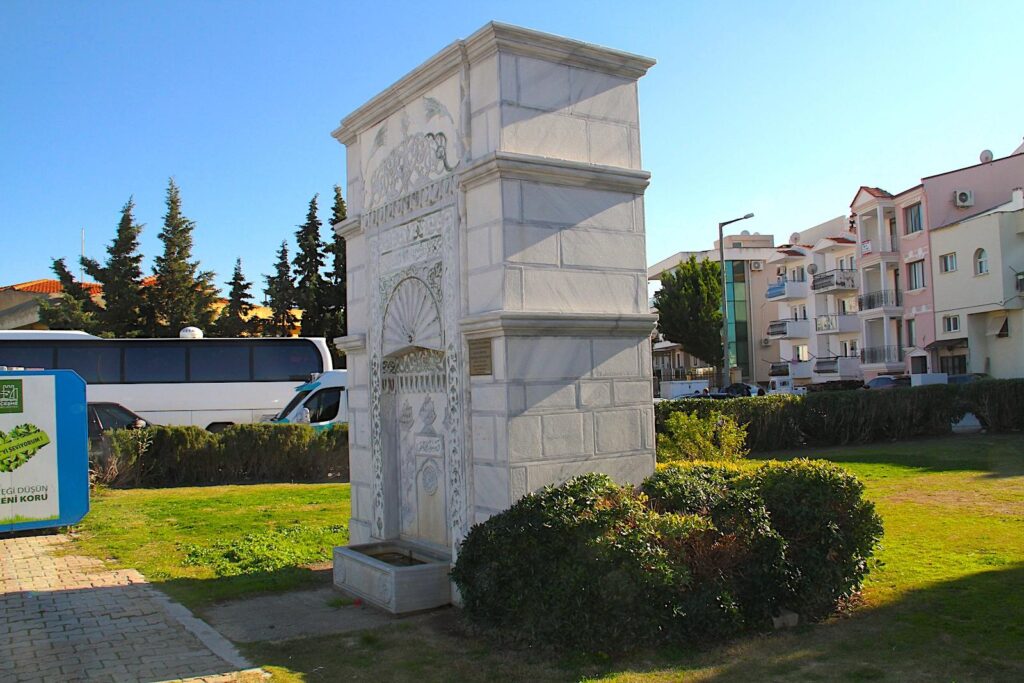
Hacı Saliha Fountain (1800)
The Hacı Saliha Fountain is located at the junction of Sk. 1015 and Sk. 1016 (in front of Osman Ağa Mosque). According to the inscription panel, it was built in 1800 by Seyyid Hüseyin Ağa, the son of Şerif Ağa and his wife Hacı Saliha, the daughter of Ehli Bıçakçı. It is freestanding and measures 3.83m x 3.46m x 2.57m. It is owned by the General Directorate of Pious Endowments and was listed for preservation in July 1992.
It was renovated and moved to its current location in the 1990s. The front façade has a niche framed with vertical mouldings at either side and two concentric depressed arches on pilasters with plain rear surfaces. It is composed of dressed sandstone with mortar. Its water supply system was initially connected to the Hacı Memiş Ağa water system through terracotta pipes. Today, it has galvanised steel pipes connecting it to the network; water is dispensed from a single spout on the front façade. There has been a considerable reduction in the length of the water-collecting barrel vault chamber, and the maintenance window was removed during its transfer.
Ahmet Karaçöl’s attribution in the study states, “Built in 1800 by Seyyid Hüseyin Ağa, the son of Şerif Ağa and his wife Hacı Saliha, the daughter of Ehli Bıçakçı” (Geyik 2007).
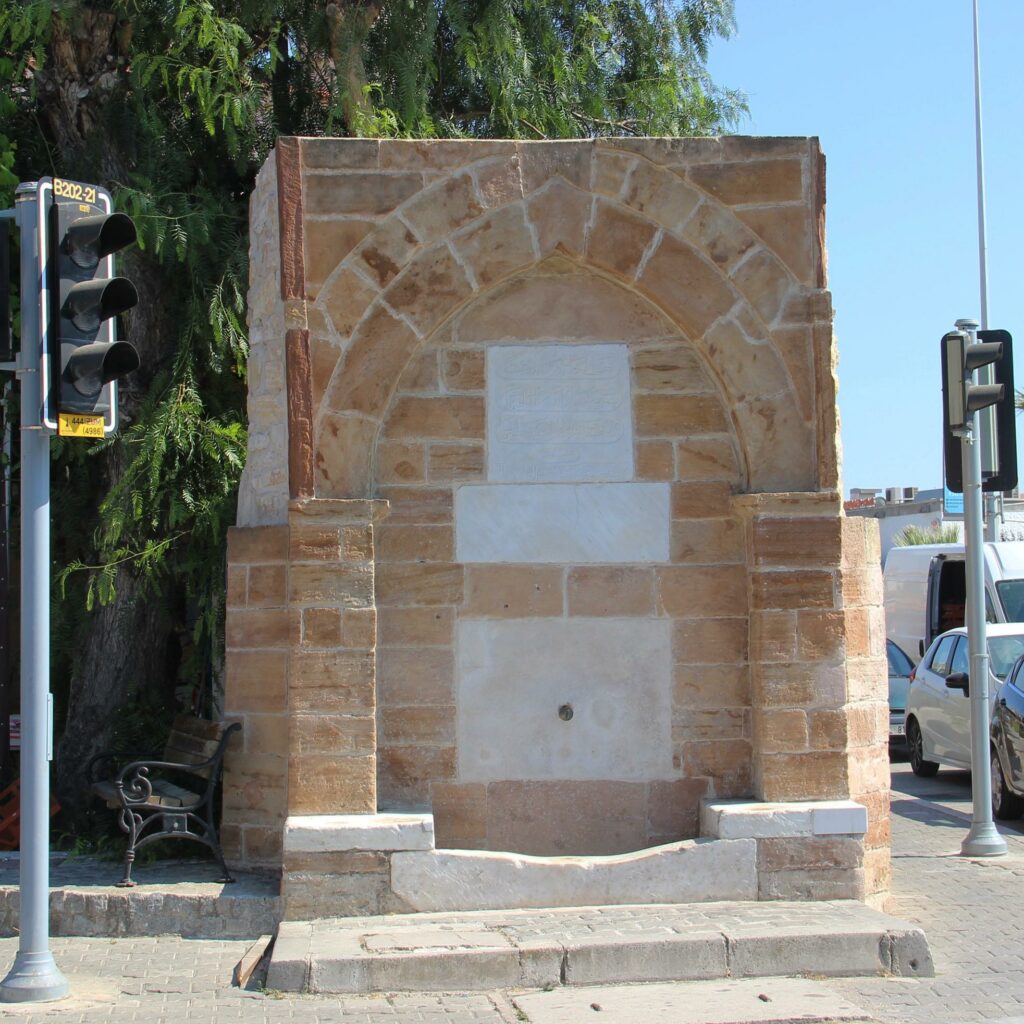
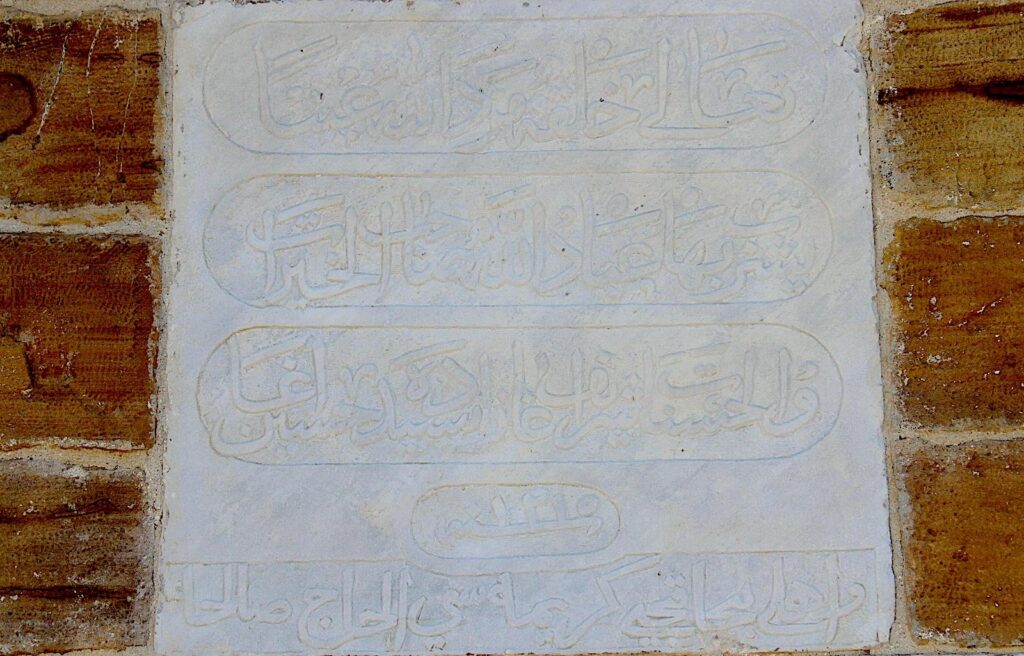
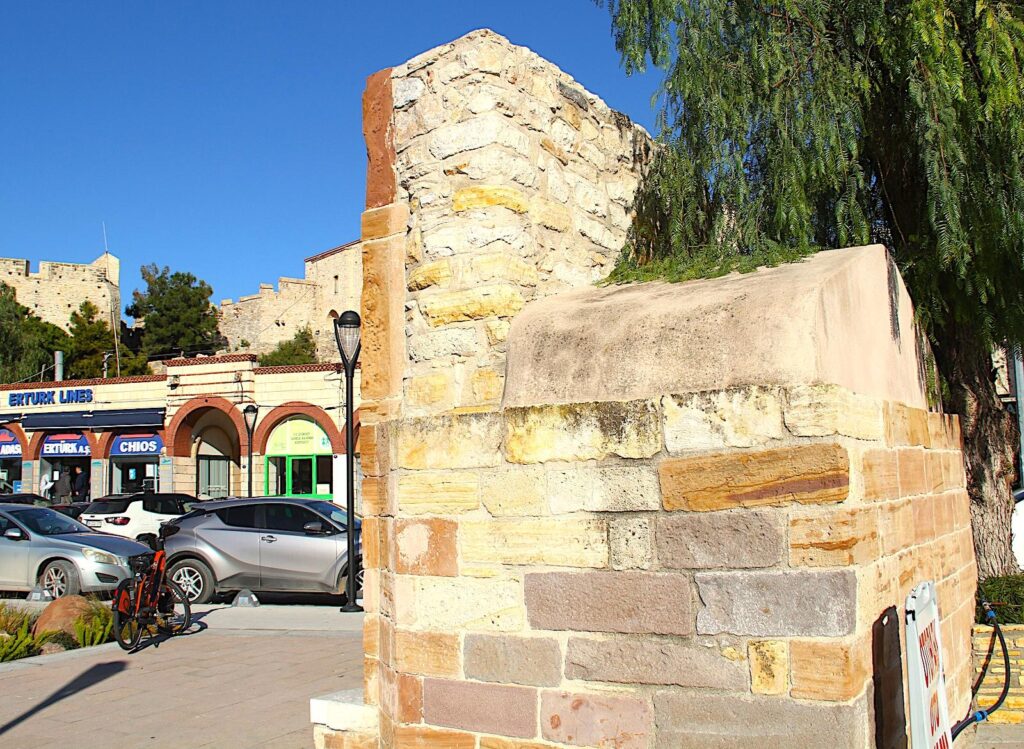
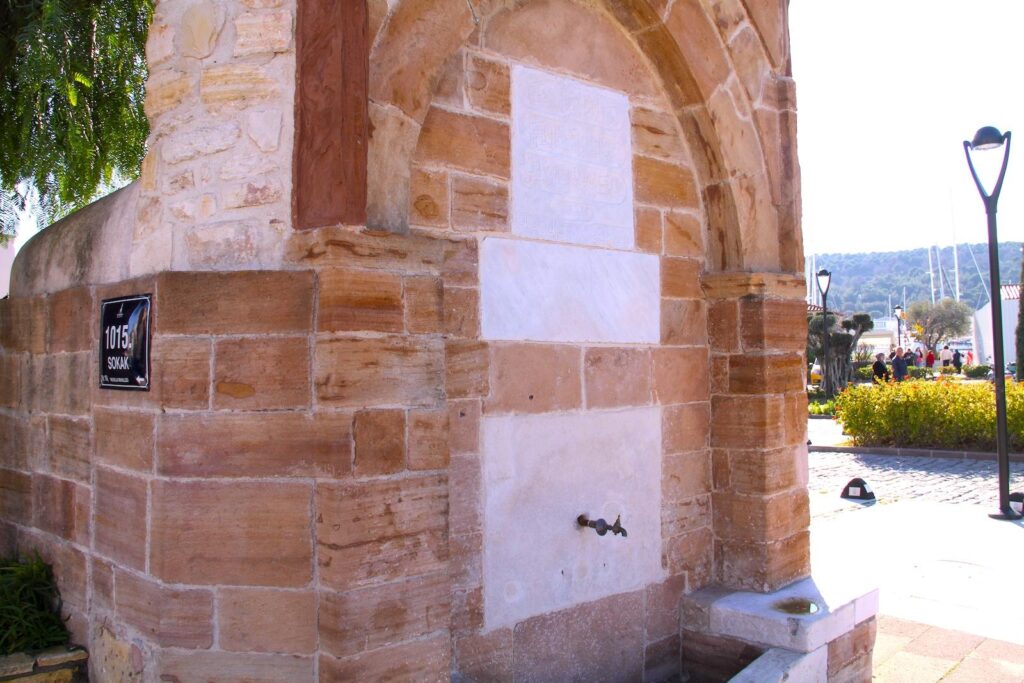
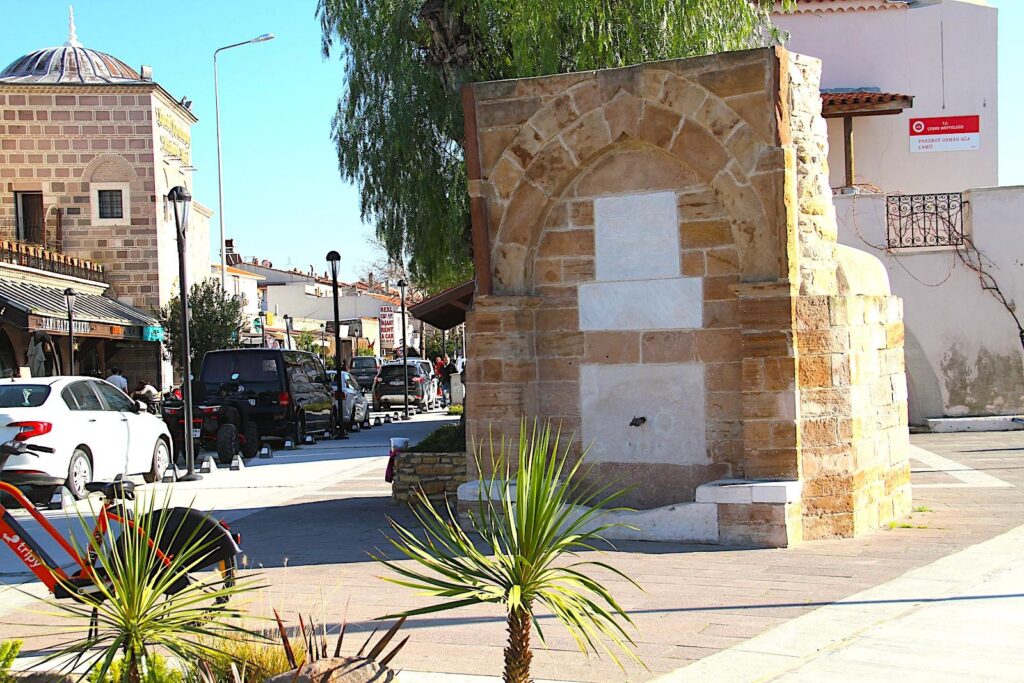
Castle Fountain (1508)
The Castle Fountain is inside the Çeşme Castle Museum, close to the original main gate (south wall) between the mosque and Çaka Bey Tower. It forms a significant part of the castle entrance camber and has dimensions of 2.57m x 4.34m x 2.54m. The fountain is in excellent condition and was restored during the extensive castle renovation. The fountain consists of a cut stone facade and rubble masonry. Beyazit II built the fountain below the castle mosque with the castle, dated to 1508 and constructed by architect Muallim Oğlu Ahmet Oğlu Mehmet, as noted on the inscription panel, possibly brought from another part of the castle.
The Ministry of Culture and Tourism owns the fountain and castle. The conservation listing of the castle was updated in July 1992. The water supply system is supplied with water collected in the castle bastions through terracotta pipes designed into the walls and installed in the water collecting chamber of the fountain. The fountain is rectangular, surmounted by fortress walls at the right, left, and rear façades. It has a barrel vault, and the façade composition comprises a niche framed with a semicircular arch resting on cut stones embedded in the wall without any protrusion. The fountain has an arch, inscription panel, jug shelves, basin and maintenance window. The inscription panel is located at the centre of the niche, and the maintenance window is on the vault.
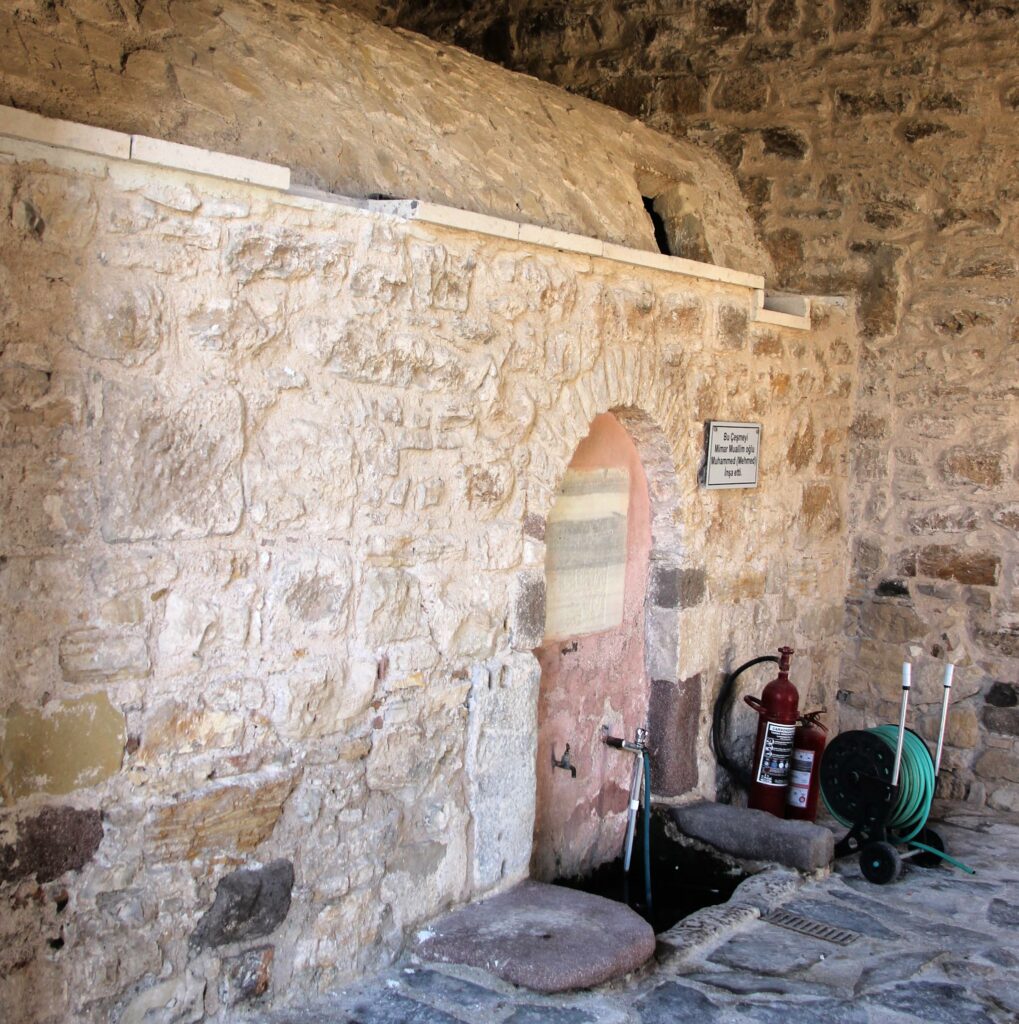
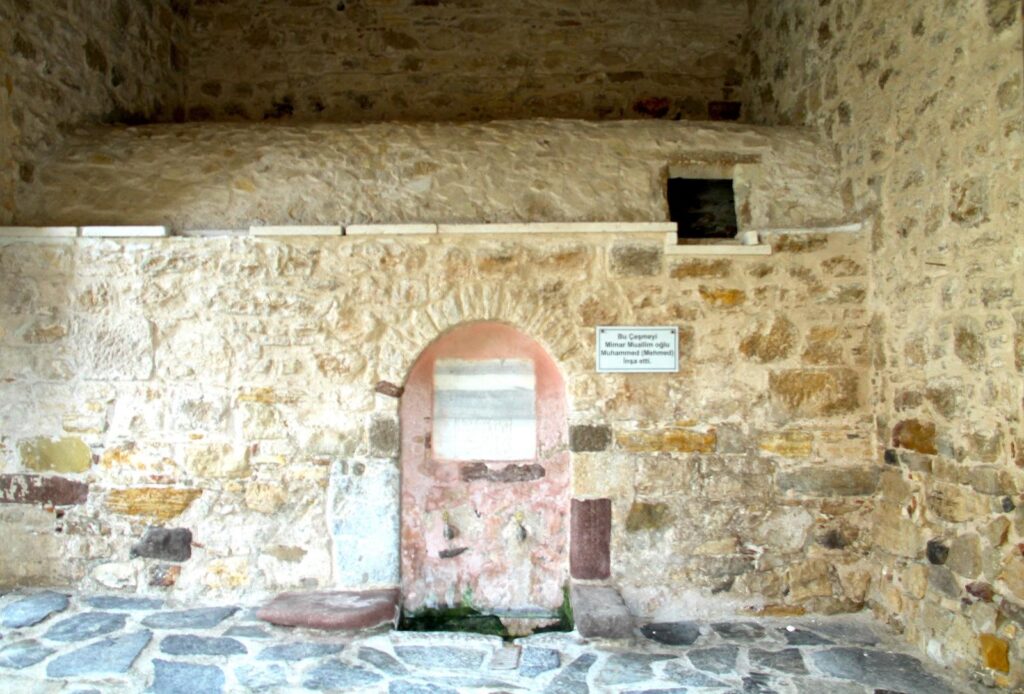
See also: LikeCesme.com “Çeşme Castle Museum”
Ilica Road Fountain (unknown circa late C18th)
The Ilica Road Fountain is located on Ataturk Boulevard (near Migros MM). It is freestanding, rectangular, and measures 3.52m x 3.18m x 0.66m. The fountain owned by Çeşme Municipality is not protected and was moved from Çeşme-Ovacık road. Currently, it forms the wall of the tyre service garage and has been seriously defaced by graffiti. The fountain consists of cut stone on the front facade; otherwise, it is constructed of rubble masonry.
The construction date and donor of the fountain are unknown, but the cut stone voussoir colours closely resemble the façade of the İlyaszade Fountain, which was built in 1780. Following its transfer, the fountain was supplied with galvanised pipes connected to the water system network, which is currently inactive. A niche formed with a two-centred pointed arch rested on pilasters, and vertical and horizontal mouldings surrounded the façade. The voussoirs are composed of red and white coloured stones. The niche comprises rows of dark and light yellow cut stone, 3.52 metres tall. The fountain elements include mouldings, an arch with impost stones, pilasters, jug shelves and a basin.
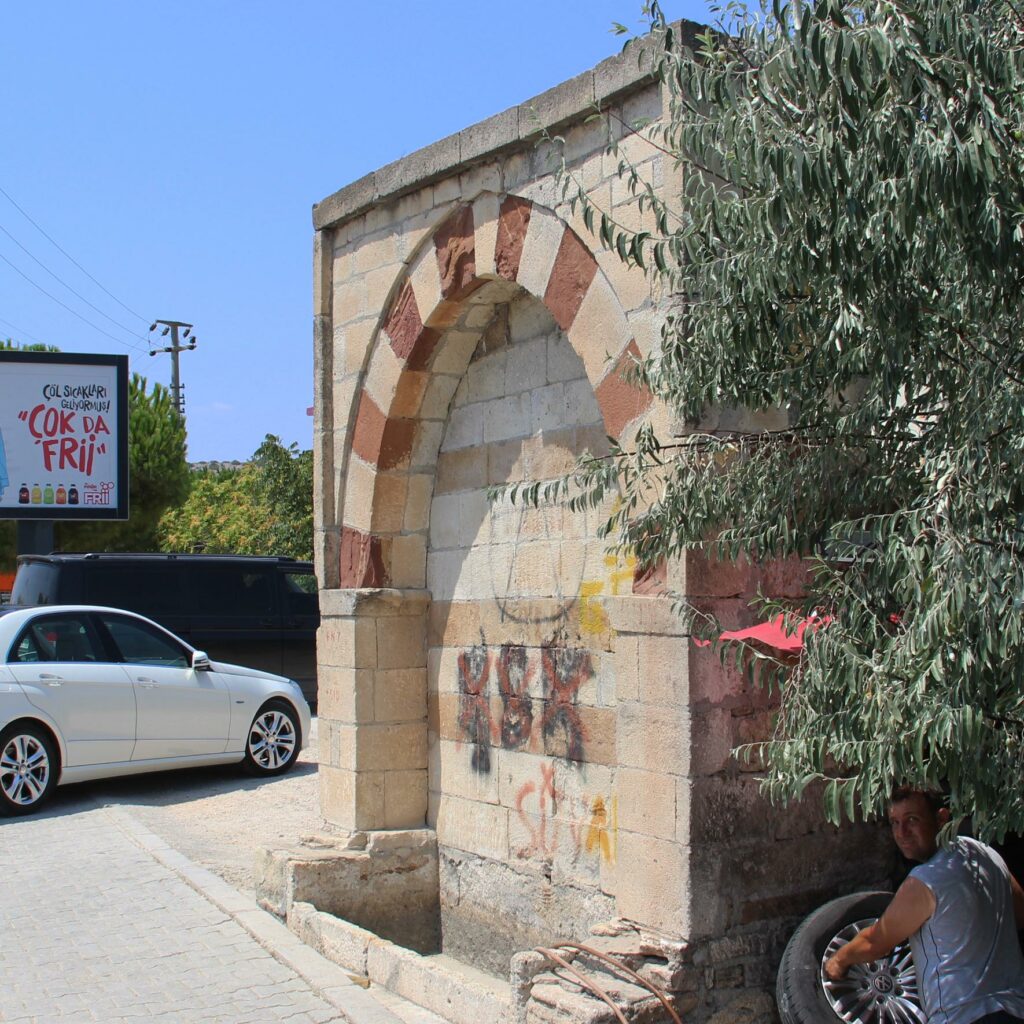
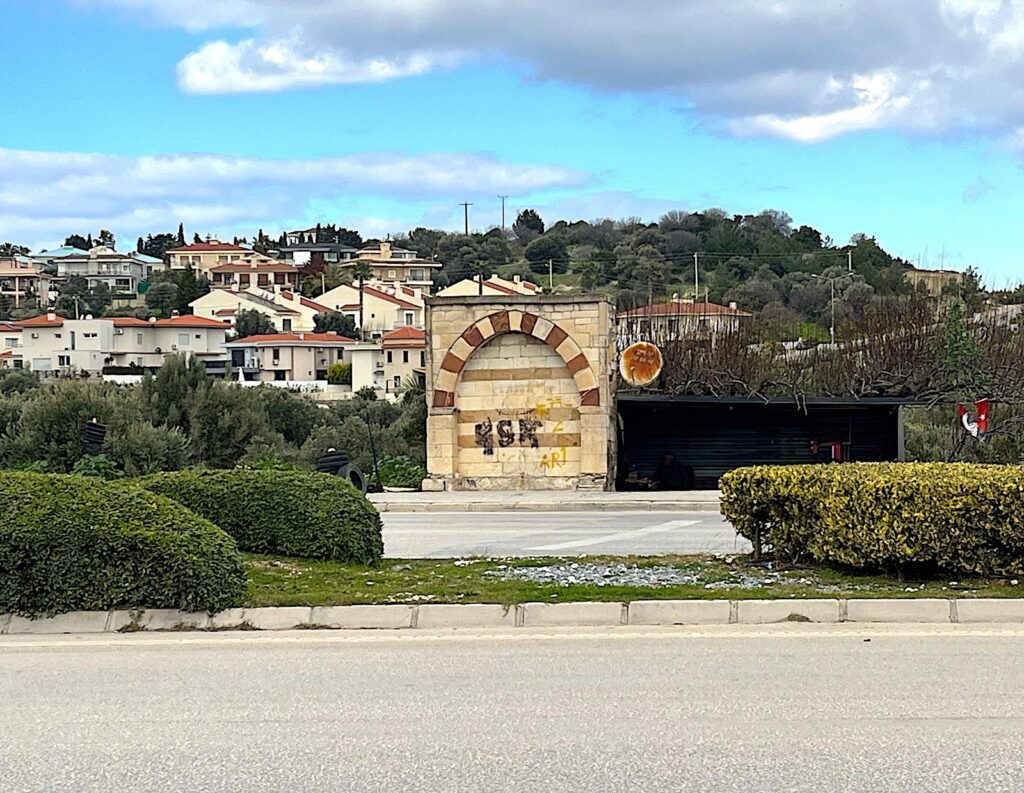
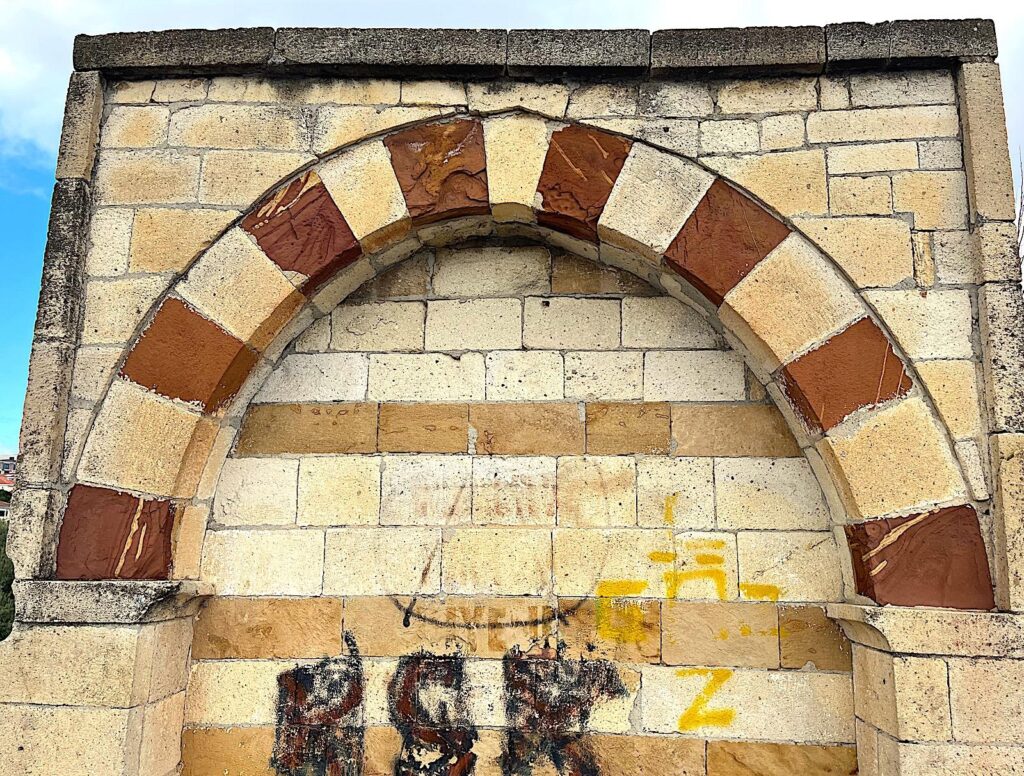
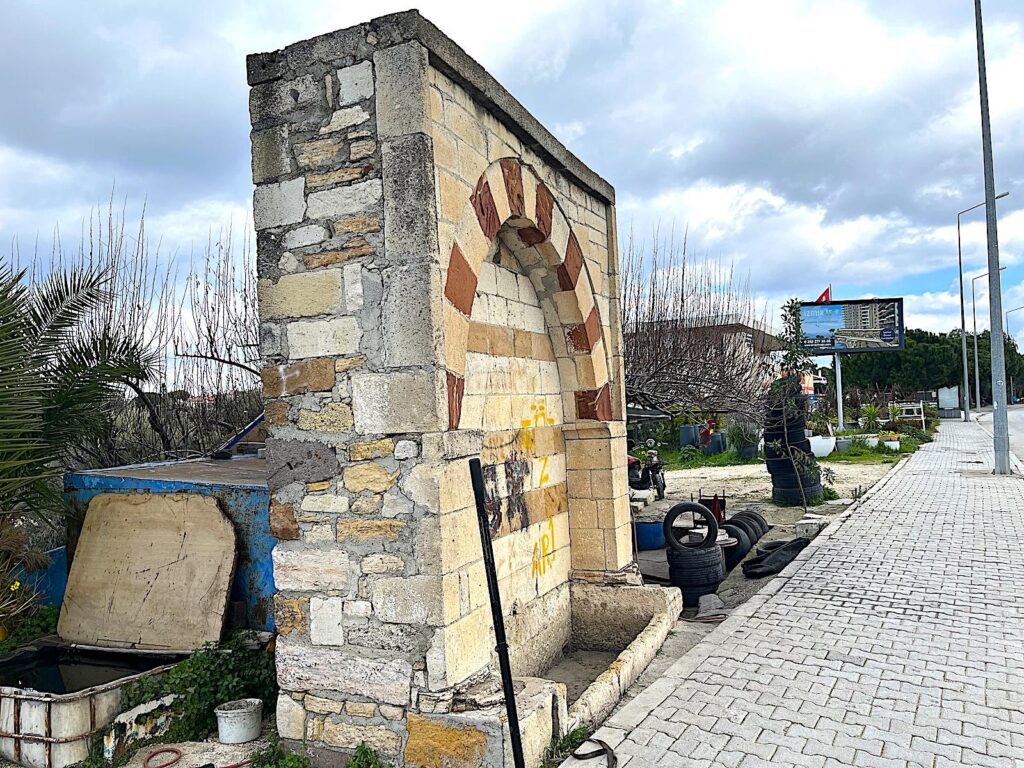
Lost Fountains of Çeşme
Köste Street Wall Fountain (Unknown – Christian Style)
The Köste Street Wall Fountain was located on the junction of Sk. 3013 (previously Köste Street) and the corner of Sk. 3019. The rectangular fountain was attached to the wall with dimensions of 2.05m x 1.78m x 0.66m. The fountain was owned by Çeşme Municipality but had no protection order. It was repaired in 1990, and between 2015 and 2019, it was overpainted in green gloss paint. The original properties of the fountain were yellow & white cut stone.
The fountain was connected to the water supply system with galvanised pipes. The façade was composed of a niche framed with a segmented arch flattened at the extrados and resting on the walls on either side of the niche. The basin remained within the mass, and jug shelves protruded outward. According to the old photographs, the arch was semicircular and possessed an ornamented fronton, with an embossed floral motive on the keystone that appeared different from the original one.
As of January 2025, the Köste Street Wall Fountain no longer exists. What happened to the ancient fountain and when it was taken away between July 2019 and May 2024 is unknown. In its place are the Zuhal Dömez Apartments.
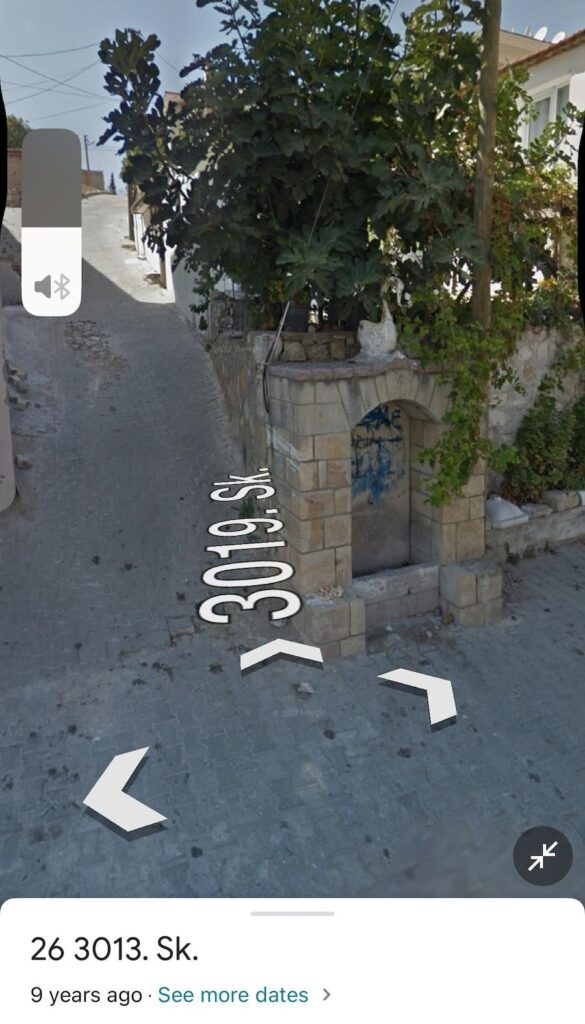
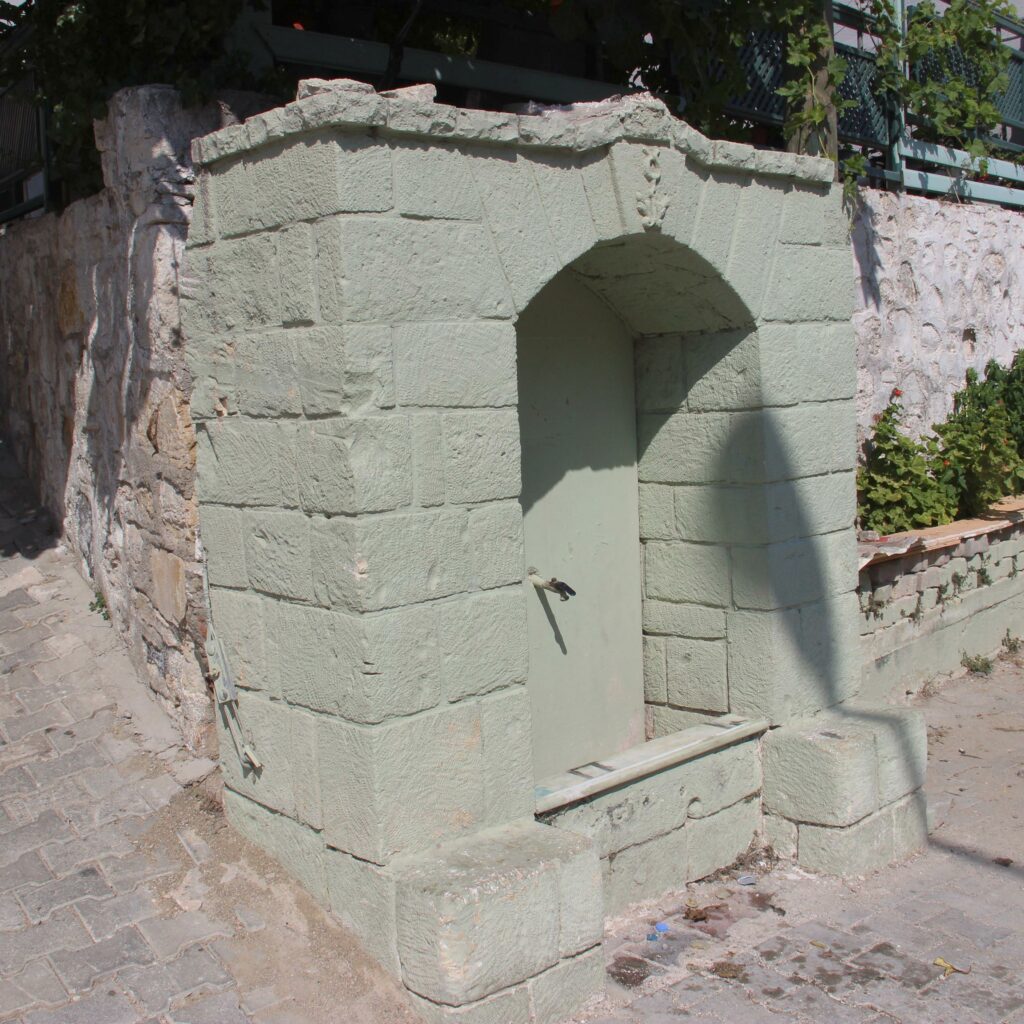
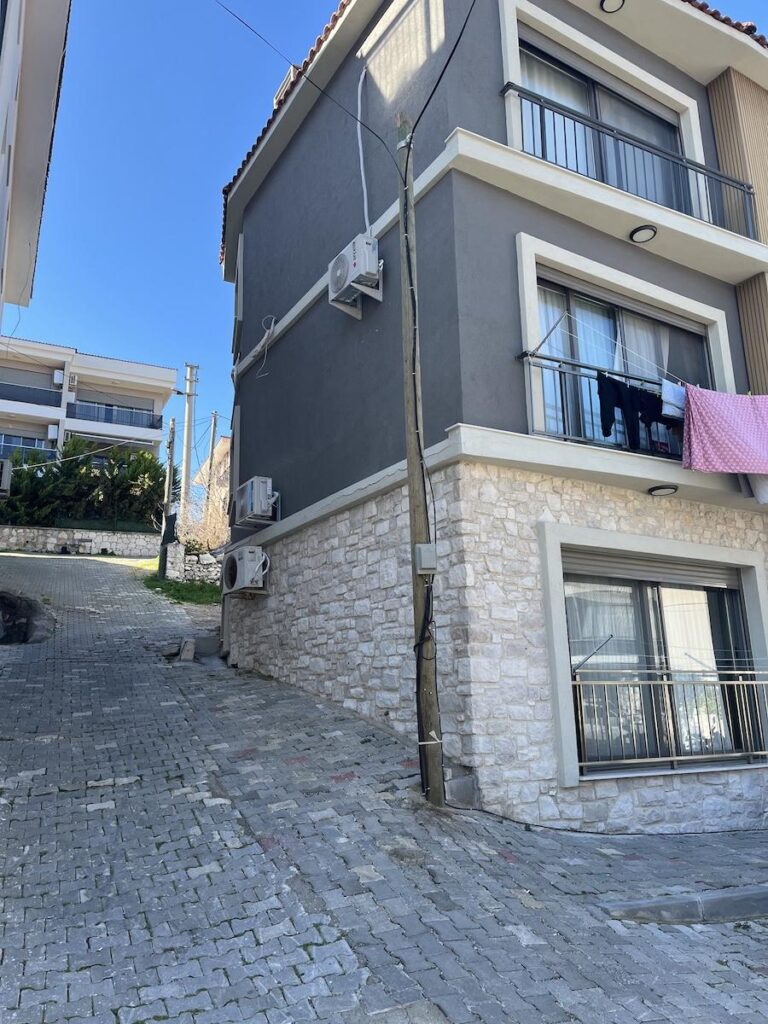
Fountains of Çeşme – Reference & Source Reading
For complete in-depth material, including detailed drawings of fountains of Çeşme, we would recommend the comprehensive study by Ahmet Karaçöl, ‘Investigation: Fountains of Çeşme the Ottoman Period Fountains in Izmir/Çeşme for their Preservation‘. The study was published in March 2011 in English as a thesis submitted to the Graduate School of Engineering and Sciences of İzmir Institute of Technology in partial fulfilment of the requirements for the degree of Master of Science in Architectural Restoration. The compilation of information on this page relies significantly on data from Ahmet Karaçöl’s thesis on the fountains of Çeşme.
